
Conventional Mainsail Reefing

Reefing or reducing a conventional/non-furling mainsail can be done by way of either a slab or a single line reef system. Today I want to talk about the difference between the two reef systems and how they should be set up.
F IRST: Read below for a few thoughts on reefing procedure

When reefing, conditions are usually rough and frustrating. Take time to first make sure that you are safe and tethered to the boat (in position to perform the reef). Try and stay calm and think clearly about what you are doing, and what you are about to be doing. Ensure all leads are fair, ensure the boom topping lift has been snugged-up (this is very important), release the vang and then the main sheet slightly so as to just luff the sail. Now release the main halyard. Be sure to pay out enough halyard so that the reef is actually below the boom. If the wind is so strong that the sail won’t lower easily, make sure the halyard is still free to run and pull the reef line and/or jack lines at the luff slides to help lower both ends of the sail. Now, continue to tension the reef line (you should be able to do this without a winch) and tuck the inboard and outboard ends to the boom. Once the reef is tucked, double check to make sure all leads are fair and take the reef line to the winch and begin to tension it adequately. Lastly, tension the main halyard, loosen the boom lift and then sheet-on as needed. When the boat is stable again and everyone is settled in, safely, go and clean up the reef slabs.
TIP: friction can easily be overcome by your winches, but be careful, because this is how things get broken!
Since more and more boats these days are leading the halyards aft , single line reefing has become a very popular method for reefing your mainsail. Single line reefing essentially means that the outboard and inboard reef cringles use one line to tuck (or haul down) both ends of the sail. In general, this system is configured in two ways:
One is to ‘simply’ run a line from the outboard dead-end, up through the o.b. reef cringle, down to a sheave at the o.b. end of the boom, which will turn the line forward to another sheave at the inboard end of the boom, which will turn the line upwards to the i.b. reef cringle, then down through a fairlead on the mast to the deck and aft via a series of (you guessed it) more sheaves , then to a clutch, and finally to the winch (gasp!).
The other method’s end result is the same (one line to pull on, back in the cockpit), but it adds yet even more sheaves. It does this utilizing ‘shuttle blocks’ which run on the inside of the boom. The shuttle block system, although providing more purchase, can cause increased friction and even worse – lines to become twisted or tangled inside of the boom; this can make it difficult or even impossible to reef the mainsail when necessary. Reef systems that utilize shuttle blocks can also be problematic in that they can limit the height of the reef point to the length of the boom. ~ Pay attention to this if having a new sail made~
I n order to make things simple we, at The Rigging Company, prefer the first system – no shuttle blocks. Although this method does not offer any additional purchase, your cabin top winches will surely be able to overcome any load that you might encounter .
For more information on leading lines aft, read here.
Additionally, it may be advisable to hang small high load blocks from the sails cringles to reduce the friction further. Also if you are noticing that the inboard end is tucking sooner than the outboard end, hanging a block from the OB end only may balance the system out a bit more.
NOTE : For either of these systems to work efficiently the boom needs to have sheaves oriented in such a fashion that the line can both enter and exit the TOP of the boom. .

Traditional slab reefing is a much more simple and classic approach. Slab reefing is intended for use on boats where the halyards are left at the mast. This system also uses just one line per reef; but this line is only responsible for the out-board/clew-end reef. Typically the in-board/tack-end is then reefed separately either via Reefing Hook (see picture) or Cunningham. A good slab reef system should lead to a dedicated winch located either on the inboard-side of the boom, or just below the boom gooseneck on the aft face of the mast (see below). If the boat is equipped with multiple reefs, all lines should be cleated using rope clutches before the winch (anytime more than one line leads to a winch the use of rope clutches is recommended). Leaving everything at the mast, properly rigged, will ensure the least amount of friction out of any reefing system.

There are many variations and details in setting up one of these systems on your boat. Please consult with your local rigging professional to determine which set up is the best for you.

Leave us a question in the comments below. We will reply!
Similar Posts
Vendee globe, single handed around the world race.
Take a minute or two and see what the toughest sailboat race in the world is up to. It has been almost 2 months and the race is about 3/4 of the way finished. Race leaders find themselves currently to the west of Buenos Aries heading north to the finish back in Les Sables D’olonne, France (somewhere I’d…
Going Aloft Like the Pros
This may seem a little long winded, but going aloft on a sailboat mast is serious business and should not be taken lightly. Serious injury or death can occur, so please take every precaution. In this article I would like to take a moment to talk about some of the methods that we use to…
The Crowhurst Scandal
Here is a really unique story that has surely left an everlasting impression in yachting history… In October 1968 the Sunday Times sponsored the worlds first single handed around the world race, The Sunday Times Golden Globe Race. This is the race that helped make Sir Robin Knox Johnston the sailing legend he is today. This…
The Old Volvo Ocean Race
With the new boats launching and the teams preparing for this year’s Volvo Ocean Race, let us take a look back, way back to the race’s debut, 1973. The Whitbread Round the World Race Digitally Remastered, Episode 1/3. Brought to you by Sailing News TV. [youtube http://www.youtube.com/watch?v=iBPMTu733-g&w=560&h=315] It seems that this race was a bit…
Views from Aloft
It is the time of year for rig inspections. Here, we are aloft in the beautiful Inner Harbor of Baltimore, Maryland. This trip aloft was courtesy of a Lewmar Electric Winch, what more could you ask for, going up!? On second thought, we could have used a bit more sunshine, but “beggars can’t be choosers.”…
Which Boom Furler is the Best?
When it comes to mainsail management systems, in-mast furlers appear to be losing popularity with cruisers while boom furlers keep popping up on more boats. We are noticing a huge increase in customers upgrading their conventional or even their in-mast units (yes, you read that right, read more below) to in-boom furling. I may even go…
Leave a Reply Cancel reply
Your email address will not be published. Required fields are marked *
Save my name, email, and website in this browser for the next time I comment.
49 Comments
- Pingback: 🥇¿Qué es el sistema de arrecifes para veleros?
I’m eager to re-configure my single-line reefing system by adding small blocks to the forward and after reef cringles, exactly like the drawing above. Where can I buy them?
Simply email [email protected] or fill out online work request form or call 443-847-1004.
I have a spare 10′ boom, and the arrangement of sheaves and mast-end jammers has me puzzled as to the sparmakers’ intentions.
At the mast/forward end, there are 3 sheave blocks with jammer handles, clearly to lock off three outboard-end clew reefing pendants…. if three were brought forward internally.
At the aft-end of the boom, there are two sheaves oriented vertically – and two other sheaves oriented horizontally.
Also, there is a cast ‘bail’ for the mainsheet attachment, and another one presumably for a topping lift and/or a fixed outhaul.
How does the team reckon I could best use these to facilitate 3 reef pendants?
[img]https://live.staticflickr.com/65535/50112313161_021c4fe5bd_b.jpg[/img]
[img]https://live.staticflickr.com/65535/50112314271_b436d59a9a_b.jpg[/img]
Are there any other line exits on the side or bottom, mid-boom section of the spar? Seems the four outboard sheaves are: preventer lines (2 horizontal sheaves), outhaul and reef (2 vertical sheaves). As far as where they should exit is a matter of how the boat is set up. At the end of the day 4 line entrances into the boom should have 4 exits.
Hope that helps and thanks for the question.
Great education on reefing. Relative to single line reefing it states to run the line to a sheave at the o.b. end of the boom. Any reason and or benefit to why the sheave is at the end of the boom and not on the boom directly below the reef crinkle?
Thanks for compliment and thanks for the read. The outboard end can include really any location away form the center of the boat, or outboard in relation to the inboard sheaves in this case. With that and your point, which is very valid, locating the outboard sheave (or turning point) just aft of where the outboard reef cringle will be located when reefed is the best possible location. This would result in the ideal 45 degree (or thereabouts) pull angle, as pulling downward and outboard is desired for a well shaped reef.
Having said that using the sheave located at the very end of the boom isn’t as ideal as one with a custom location as you are suggesting. It is just that most generic booms are manufactured with 3-5 sheaves on the outboard end cap. This is more versatile and will function well with any sail, no matter where the reef cringles are located. But your idea is the ideal world scenario….
Tx. Not sure I understand the reference to 45 degrees. My suggestion would be set up like your slab reef diagram, which would result in close to 90 degree angle at the sheaves.
Slab reefing, jiffy reefing, single line reefing, shuttle block reefing, in-board/ out-board line reefing….all the same. You want to pull the outboard reef, not just down, but also out. This will reduce the hoist of the sail as well as tighten the foot. It will serve as your new outhaul.
how does one deal with the problem of the lowest luff slide hitting the sailstop before sail is lowered enough. taking out sailstop & then replacing in windy conditions no fun. another option is mast gates, or separating the lowest slide from the sail. any other ideas? many thanks.
The short answer is sailgate. Shame the sail entry slot is so high that it makes the sail awkwardly high. I am assuming this is the problem. Send along some pictures to [email protected] and maybe we can help further.
Thanks, ~T.R.C.
Thanks for the informative blog post. I just bought a new boat and recently had the single-line reefing system installed. All my reefing is done at the mast and I am fine with that, but I am questioning the way that the reefing lines were rigged. At the bottom of the boom, close to the mast, I have two Selden jammers – one for the 1st reef and one for the 2nd. However, the line that comes through them is a loop, so there is one continuous line rather than two separate reefing lines. Why I am confused is because it is called a “single line reefing system”, but it seems awkward to manage the looped line under the boom. Moreover, it prohibits me from effectively using a winch at the mast to winch the reef tack. I noticed that all “single line reefing” systems that run to the cockpit have two separate lines. Why should it be different if I reef at the mast instead of the cockpit?
Thanks for the kind words. This is likely a shuttle block system. Feel free to email us some pics (zoom out) of what you have to [email protected] and we can help further.
- Pingback: What Is Sailboat Reefing System - Globo Surf
The two ends of the boom have sheaves which slide down into slots and are held in place by gravity and the downward pull of the reef lines. To change to single line reef, the force on the lines would be up. How to secure the sheaves in place?
Sounds like Isomat? The quick answer is you don’t. You turn the line down to a block (or double block) on top of the vang then back up to the sail.
Click the link for an image…
https://theriggingco.com/wp-content/uploads/2019/04/IMG_9758.jpg
I live in New Zealand and sail in the Tasman and the Pacific which can be windy on occasions.
I have a Beneteau Oceanis 50 with 3 single line reefs (In boom pulley cassette) Plus 2 cringles for reef 4.
When reef 4 is needed it will obviously be blowing a bit. How do I rig a reef line to the clew cringle?
Option 1. Do I set up a reef line in advance (attached around the boom, up to the clew Cringle and back to the end of the boom and hanked there) The problem with this is a large hank of line hanging off the end of the boom.
Option 2. Fasten a reef line to the boom in the position where the 4th reef would come down too. Hank the remaining line there, Maybe a bungee to hold the hank out of the way. This reef line would be a lot shorter than the one in Option one as it would only be used when pulling down from reef 3 to reef 4. The problem being when the main is bought down to reef 4 cringles and put onto the tack hook the clew end will flapping around strongly and it would be very difficult to thread the reef though the cringle and back to the boom end.
I would appreciate all suggestions of how to approach this issue
Regards Ken
Happy Holidays! As this other article states, we would recommend that you lead the reef line aft (as I am sure the others already are) to accompany the main halyard. This is the safest, simplest and most functional method of adding a 4th reef in our opinion.
Depending on how the boom is configured (e.g. available sheaves in and out-board) you may be able to run this internally for the cleanest look. Otherwise the addition of some cheek blocks, of course the line, fairleads and perhaps some additional blocks and a clutch maybe needed; so that it can be operated from near the main halyard (and boom topping lift in case there is no rigid vang present). In either configuration, internal or external, a true single line reefing system should be use (see the single line reefing diagram in the article above).
We hope that this helps. Please feel free to send us some pictures of the boat in it’s entirety, the boom, and also the cabin top area from the mast, aft. Zooming out is always preferred.
Email [email protected] .
Thanks for the read!
I am new to big boat mainsail reefing and wonder if you could explain that sometimes you see the dead end of the reefing line tied around the boom with a a bowline and other times I see it is not tied but rather around the boom and then looped around the boom again but now wrapped around multiple times around the first loop. Why is to done this way and what is best.
Hi, As long as you are dead-ending somewhere at the boom and not up at the sail cringle itself there really is no wrong answer. Some like the Bowline being tied back to itself so that it cinches around the boom. Some sailors like to tie the bowline around the boom so that it slides. I personally like the latter. I like to think that once the cringle is down near the boom, now I want the bowline to slide aft (not cinch) in order to haul the sail out.
….hope that helps.
Please explain the placement of the block or blocks needed to position the single reefing line at the reef tack. After exiting the boom running forward, where does the reefing line go next? I’m concerned about the reefed tack being pulled too far aft once the reefed foot is tightened adequately for high winds. Seems to me that one or even two blocks may be needed, one on each side of the mast at 45 degrees down from the tack.
Some boats I’ve sailed on, required an additional line to be tied from the reef tack, around the mast, to hold the tack in correct position close to the mast. Tack hooks are sometimes too far aft to avoid stress on the first sail slide above the reef. It would seem to be even a bigger problem with single line reefing.
HI Douglas,
If you notice in the picture … https://theriggingcompany.files.wordpress.com/2013/03/cslr-150dpi.gif
…the reef lines are led through fair leads at the mast, placed just below the boom gooseneck. This will ensure that the tack is being pulled forward and down. You can use a Schaefer Halyard restrainer…, https://newcontent.westmarine.com/content/images/catalog/large/285538.jpg
…but mounted upside down and drilled and tapped into the mast. You can see one of the two we mounted here… https://theriggingcompany.files.wordpress.com/2018/03/img_20171205_135848857.jpg
We can even make one custom but need a profile of the aft edge of the mast for that… https://theriggingcompany.files.wordpress.com/2011/11/img_20170419_170029981.jpg?w=488&h=275
Hope that helps a little.
Hello, You mention using blocks hanging from the cringles to ease friction on the reefing lines: “Additionally, it may be advisable to hang small high load blocks from the sails cringles to reduce the friction further.” How would you calculate the load capacity of the blocks needed in this case? Thanks, Joe
I have a Beneteau 50 with single line reeling. The manual shows blocks on the reeling points at the aft end of the main but none are fitted. What type of block should be used and how should they be attached to the sail? Thanks
Thanks for asking. Lately I’ve switched from using blocks to friction rings. See this link… http://www.antal.it/ENG/197_rings_with_loop_en . Depending on whether or not you have a webbing sewn on to the sail for the reef cringle or a pressed-in grommet, you would either lash the ring straight to the webbing and then pass the reef line through it (ideal). OR, in the case of the pressed-in grommet, you can purchase the loop and ring (as shown in link) and simply cow hitch a stainless ring, big enough so that it won’t fall through the grommet, likely 3/8″ round stock for strength, to other end of the loop to keep it captive on the sail.
Alternatively you can use these same methods of attachment with a lightweight, strong ball bearing block like the one found here… http://www.harken.com/productdetail.aspx?id=4751&taxid=415 . Just make sure that it meets the rope diameter requirements found on your boat’s reef lines.
Lastly, IF the sail’s reef points are equipped with these pressed-in grommets and also feature a “Dog-bone”, which is a piece of webbing with a ring sewn into both ends to keep it captive on the sail (much like the loop and ring method described above), you can simply shackle a block to this “Dog-bone”. OR, you can cut it out and do the loop ring method mentioned above (preferred if equipped with Dog-bone).
I hope that helps and that it is not too wordy. Call us if you have any questions,
- Pingback: Reefing masterclass | Sail Fast Live Slow
Hi, I have a slab reeking system with a reefing hook. My question: if I’m using the 2nd of my 2 reefs, do I need to reef the lower one first, and then secure the 2nd reef as well, or can I just use the 2nd higher reed to shorten my sail? Thank you.
Hello Robert,
If you have reef lines rigged through both cringles then yes, you should be able to just go straight to the second reef and omit the first.
when reefing , is it advisable to allow the uphaul slides to come off the mainmast track or do you keep them on?
Either or is fine. I think it makes for a better looking reef to dump all of the slide below the reef that is being used. This minimizes bunching at the tack and allows for the slab to be tucked away nicer.
It is more effort though. Therefore, I reserve this when needing to be reefed for longer stretches.
Hi there in the U.S.!
I have a plan to make a single line reefing system on my 43 year old Hallberg Rassy Monsun 31 berthed on the south coast of Sweden. She is now equipped with a well working slab reef. The idea is to draw the lines down to the cockpit by some drilling and fixing. I have discussed with people and they say that friction is the main problem to overcome. After extensive thinking and paper drawing, but still not testing, I have come to the following solution: The line starts with a knot in the outboard cringle in the sail. Down to a sheave near the rear boomend. Ahead to a sheave on the boom front. Up to a block in the sail inboard cringle. Down to a block on deck and then aft. That would make a sum of 4 blocks/sheaves and no passages through rings. The drawback would be that everything will be on one side of the boom. I dont know if that will make the sail inefficient in any way? My thoughts is that this construction would minimize friction. What are Your comments on this idea?
That’s exactly how it’s done. Just don’t forget to add the fairlead at the mast, below the gooseneck. See the drawing for single line reefing in the article. Thanks for the read and let us know if you need more thoughts.
@ Howard: You didn’t REQUEST a third reefing point??! You probably don’t need it then so just ignore it. I have three reasons for a third reef, and it took months to figure out how to rig it for its intended uses. Assuming we are talking Bermudian/marconi rigs, the third reef is not in the same location as the usual “top reef” – you would (logically) only have a third reef for a high-aspect mainsail, the location reduces sail area to about that of a trysail.
That third reef point is a lo-o-o-o-ong way up there, and even though my boom has room for a third line (the old main had a flattening reef) I didn’t want a reefing line going up there for a reef I will seldom use. One of my reasons for the third reef was to have an option for an emergency/temporary trysail, so my whole system had to be designed for that use (severe storm conditions and there is a problem if my trysail isn’t deployed instead), plus my personal needs (blue water singlehanding requires a fast and easy way to rig the reef clew ring in rough seas so I can quickly get away from the boom and off the cabintop, and simple enough it can be accomplished at night while I am tired or possibly injured). I did extensive research for how to hook up the reef clew ring on that third reef and didn’t find anything useful, so I designed a system that fulfills all my requirements. If there is any interest I might write an article about it for Ocean Navigator later this year.
I have had a new mainsail made and the sail makers provided 3 reef points as opposed to the two specified, I have only two reefing lines. I questioned whether the spacing between the reefing points should be different for a two reef system as opposed to the three point system. they tell me that the distance between the reefing points would be the same, they would simply not provide the top most reefing point. Is this correct ?
Hi Howard, This questions is typically better suited for <a href=”http://www.chesapeake-sailmakers.com/”>a sailmaker</a>. Here are my two cents..I believe that the top reef is always at about the same location. The fabric weight can only handle so much and reducing sail beyond that would require a different (heavier) sail. The amount of reefs you have just break down the area below that top reef. Much like a transmission in a car, if you have a four speed you can still go 85 VS a 6 six speed, there are just more shift points before you get to 85. Does that make sense at all?
I wouldn’t fret about not having that third reef line You can rig the two points in the sail that suit your most likely conditions. If you are on the Chesapeake you’d likely leave that third reef alone. What you can do is rig a small diameter loop between reef 2 and 3 so that if you need access to that last reef you can take the reef line that is slack and feed it up through the top reef via the messenger loop.
Hope that helps!
Thanks for that, I follow your reasoning and it makes sense. However I doubt I’ll ever sail in Chesapeake bay, the Solent in the UK is my main cruising area!! Fair winds and happy sailing.
Sweet! You’d better rig reefs 2 and 3 then ;). I love that we have readers in the UK.
I would like to get another shuttle block for my Freedom 35 and see if it works for me. Can you supply me with one?
Absolutely. 1st try going straight to the source .
Sometimes they can be a bit difficult to deal with. If you have troubles please call our Bradford in the office and he will see to it that you get the exact part that you need.
Regards, TRC
Hello I have a reefing system with a kind of blockers in the boom and I can’t find how it’s worked?? This system block in the 2 way!! I have some pictures to show you!! Needs help please!! Marie
Hi Marine, Send us the pics and we’ll try to help. send to [email protected] or [email protected]
you say “hanging a block from the crinkle”, how? using a snap shackle, or sewing a block on so that it ‘hangs’ down , but then the line would all be on one side. confused !
Hi Ruth! Yes, you can hang a block or a friction ring (Google Antal friction ring with loop). There are a few methods to achieve this and yes, it would result in the line going up and back down the same side of the sail as it won’t pass through the sail anymore.
One is to use a Dyneema loop with a ring hitched to it on one end (the ring keeps it captivated in the cringle) and hang the block or friction ring from it.
Another is to have sailmaker sew a webbing loop to the sail and hang a block. Lastly, you can have the sailmaker sew in webbing with two rings, that is rigged through the cringle (much like the Dyneema loop and ring mentioned above) and hang the block from it…. called a “Dog Bone”.
Hope that helps and thanks for the comment.
Can you please explain the correct way to secure the cringle to the Tack End Reef Hook without punching a hole in the sail? thanks.
LOL well, it is slightly funny that you say that. I just went on a sea trial last week with a customer to use their new single line reef system, which omitted the old reef hooks. And guess what happened…one of the flakes of the sail, while reefed, caught on the stupid reef hook, which aren’t even needed any longer and poked a hole right in the sail.
So, there’s my story, but if actually using the reef hook correctly it should not be doing that. Simply lower the halyard, hook the cringle onto the sail and re-hoist the main. You’ll need to hold the cringle in place until the tension of the halyard does this for you. Using reef horns at the tack are only recommended if the main halyard winch and cleat are also on the mast so that you can manage both of them at once.
If this is not the case and the halyard is led aft, then it will be a two man operation, OR re-rig the reef lines as single line reefs, OR re-rig the main halyard so that it is at the mast.
Hope that helps.
Did I miss read the articles? Where does it say release the vang or kicker? The procedure I’ve encountered most would be. After making ready all lines and winches required.
1 Release kicking strap or vang. 2 Ease sheet. 3 Ease halyard 4 Secure new tack if not on single line system 5 Take up on reef line. Also hand pull tight all other reefing lines. 6 Retension halyard. 7 Trim vang and sheet. 8 Check over all blocks and wear points, use sail ties to secure reefed sail to boom.
Coil all lines etc.
No miss read, I forgot to mention the vang. You are correct. Please note the addition and thank you for the comment. ~T.R.C.
Hi, thanks. Am happy to have my name published for potential work! If you get my drift.
David Broadley RYA Yachtmaster.
David, we always welcome guest bloggers if that’s what you’re getting at please email [email protected] .
Username or Email Address
Remember Me
Lost your password?
Review Cart
No products in the cart.

- Privacy Overview
- Strictly Necessary Cookies
This website uses cookies so that we can provide you with the best user experience possible. Cookie information is stored in your browser and performs functions such as recognising you when you return to our website and helping our team to understand which sections of the website you find most interesting and useful.
Strictly Necessary Cookie should be enabled at all times so that we can save your preferences for cookie settings.
If you disable this cookie, we will not be able to save your preferences. This means that every time you visit this website you will need to enable or disable cookies again.
Home > Resources > Reefing 101: How to reef a mainsail and when to do it
Reefing 101: How to reef a mainsail and when to do it
17 September 2019
Ask Precision Sails , Design , Featuring - Partners , Hardware , Headsail , Mainsail , Sails , Technical Tags: furling headsail , How to , reduce sail area , reefing headsail , reefing mainsail , sail area , sail reduction , sailcloth durability , sailcloth stretch resistance , sailcloth weight , sailing uma
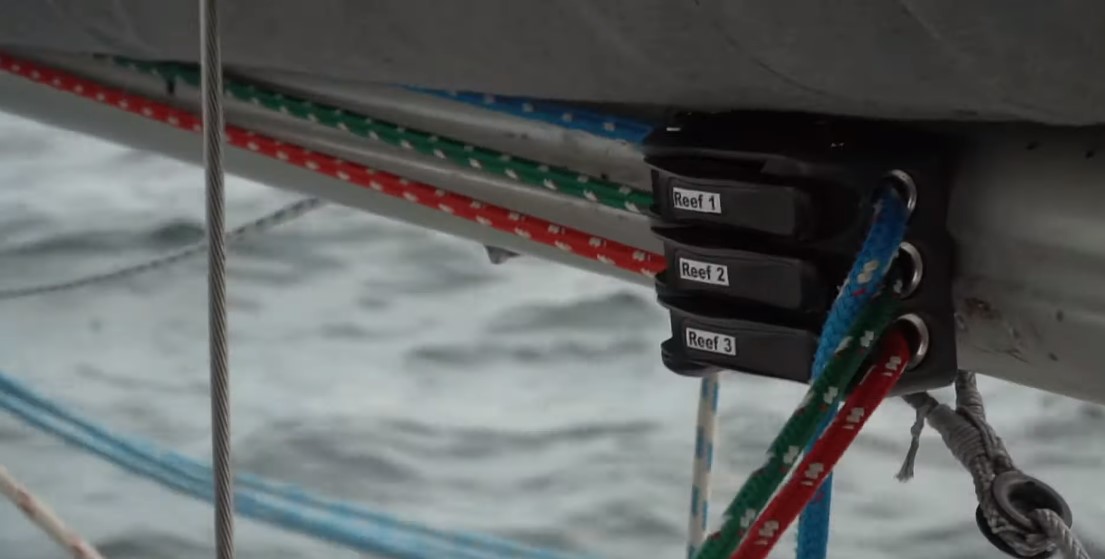
Reefing is meant to increase your ease-of-use, flatten sail shape, reduce sail area, and re-position the boat’s center of effort. This reduces heeling and de-powers your sails to improve safety and stability in rough weather.
Reefing is an important part of sailing to learn and understand how to do efficiently and effectively. This guide is meant to give a general overview of the process and discuss the preparation a sailor should take. There are various methods of reefing and each sailor has their own process. Nonetheless, whether you are slab reefing, in-boom reefing, in-mast reefing your mainsail, or furling in your headsail the principles remain the same.
Preparation is essential
Being prepared for heavier winds and identifying when to reef is key to maximizing the performance and safety of the boat. Here are several things every sailor can do to be prepared:
Keep lines organized
Make sure to have your lines organized beforehand and a reefing plan in place. This will assure that each time a crew member reefs the same actions are taken to re-organize the lines so no time is lost figuring out what the preceding person has done.
Practice Makes Perfect
Taking time to exercise your reefing routine will ensure that your crew is ready when that gale approaches. Additionally, having a plan in place will keep your crew focused during turbulent weather by overcoming their hesitation with confidence to handle the situation swiftly and correctly.
Check the Forecast
With the multitude of devices and apps which show weather patterns, wind speeds, and forecast predictions available today no sailor should be fully unprepared for the weather they are going to face.
Reef Before You Need To
When it comes to knowing when to reef, not every sailor, boat, sail or breeze is equal.
“It depends on the boat, and the sailor,” says one of our designers, Jeremy Roszmann, “more cautious sailors will reef earlier, and some boats will heel more in different winds”. A boat’s design, sail inventory, and crew experience are all factors in determining when reefing should take place.
“It’s pretty difficult to give an ‘at 15 knots take your mainsail to reef 1’… headsails sort of follow the same line. You can theoretically run your 150 Genoa up to 20 knots, and I’ve had clients ask for extra reinforcements because they do, but you risk causing undue stress on the cloth, running into shape issues quicker and in-time sail failures”.
One common saying about reefing is that if you think you need to reef, you should have already reefed. “I avoid telling clients when to reef because if they feel they should reef, they should. Until either, they are more experienced sailors or they are more comfortable sailors”. Every boat is going to handle wind speeds differently due to their design and sail inventory. It is important to practice reefing so that you can be fully prepared and know when to reef before you need to.
How to Reef
While there are many methods to reefing the core concept is the same: to efficiently reduce sail area in order to stabilize the boat in varying winds. Sailing Uma has made a wonderful video on how they go about reefing their mainsail, watch the video below and visit Sailing Uma’s partner page , and website to show some support.
Reefing your mainsail
- Ease the main-sheet. This will cause the mainsail to luff, stabilizing the boat by reducing heel and easing the tension on the mainsail making it easier to drop.
- Lower the main halyard, and hook the reefing point onto a carabiner or ram’s horn to set the new tack position of the sail. Tie sail ties around the boom through the grommets if necessary to contain the loose material left over. If you use a stack-pack the loose material will be gathered inside the folds.
- Haul in the first reef line.
- Tension the main halyard. Don’t be afraid to crank it tight, your sail is reinforced at it’s Cunningham.
- Tighten up the boom vang in its new position.
- Trim the main-sheet.
- Bonus Uma Tip : Stow your main halyard and lines, in the same way, each time. Then no time is wasted figuring out what the previous person had done.
Shaking Out a Reef
Follow the above steps in reverse order, making sure to re-tension and trim for the new position of the sail.
Don’t Forget Your Headsail
Adjusting your Genoa or Jib can help balance out the boat and reduce heeling. Furling in your headsail is a great way to reduce sail area.
Simply furl in your headsail as you normally would but stop prematurely to determine the size reduction you want to make.
For areas with seasonal variance in wind strength or for those sailors traveling to areas with different conditions, if you find yourself constantly furling your 150% down to 115% that you might want to consider increase your sail inventory. When you constantly are partially furling your headsail you are doing two things:
- Furling away sail shape which causes a decrease in performance compared to a sail meant for the conditions.
- Increasing the pressure applied to the unfurled portion of the sail while the other portion remains untouched from the stretching causing your sail to become “baggy” over time.
How Many Reefs Should a Mainsail Have?
Again, this will be different based on the sail inventory, experience, boat, and sailing conditions for each person. Ron, our Lead Sail Consultant regularly recommends that “one reef keeps you sailing, two gets you home safely”.
Can Reefing Damage Your Sails?
The size of the sail, cloth weave, weight, and design will all play large factors in determining how fast a sail will stretch. As Jeremy said earlier, “you can theoretically run [a] 150 Genoa up to 20 knots… but you risk causing undue stress on the cloth, running into shape issues quicker, and in-time sail failure.”
Think of it this way, if you have a 150 Genoa and you are furling it to a smaller size constantly due to the wind conditions where you sail you are not only furling away sail shape (making it less efficient) but you are also using the sail outside of its intended conditions. Having a few sails in your inventory, like a 115, 150, and a Trysail is a great option as it allows you to reduce sail area more efficiently depending on the conditions.
“Reefing sails to induce the qualities of another sail, i.e. reefing to third reef instead of a Trysail on-board, can damage specific areas of the sail, damaging the smooth vertical representation that we design in the sail. In the example above you would slightly bag out the top of the sail which means that you have a deeper top which encounters higher velocities, and could cause weather helm in the boat.”
Likewise, if you are constantly reefing your mainsail to the first or the second reef the exposed area is being stretched at a greater rate than the hidden section. This can cause the sails to become baggy and impairs the efficiency of the design of the sail.
This isn’t to say you shouldn’t reef. Well built sails will be able to handle the strain that comes from sustaining a reef and there are many ways to reinforce your sails to prolong their lifespan.
Panel Layout and Sailcloth Weight Are Important
Higher quality Dacron sailcloth has increased resistance to stretch and UV damage to prolong their shape-holding life. Meaning you can sail more aggressively without being concerned about stretching too early. Tri-Radial Dacron sails have greater resistance to stretch due to their design and the load-bearing properties of the seam layout. Laminate sails are the complete solution to stretching, but unfortunately, lack the resistance to UV that is needed for longevity. You can learn more about sailcloth and crosscut vs tri-radial designs in our blog.
Cloth Weight
For a long time it was thought that the heavier the sailcloth, the better the sail. We still get asked this question everyday but heavier cloth does not mean that it will last longer. Here is what our designer Jeremy had to say about it: “Cloth weight is determined on the size of the boat, usually in LOA (ft/m). Larger boats induce more displacement and require a larger sail which will have to undertake more force to move the boat. Too light of cloth, while providing superior performance, risks tearing or warping very quickly. ”
Design is Crucial for New Sails
The design of your sail is a crucial step in preparing your it to perform well in heavier winds. Precision Sails prides ourselves on our leading design consultations to build the best sail possible for your boat. Our designers get to know you, your boat, the conditions your sailing in, long term plans, and experience level to select the best cloth, weight, and features for your sail. Here are some of the features your new sail can have:
“A foam luff allows you to furl in the sail partially and maintain lift in the front camber of the sail, this allows someone with a 150 Genoa to furl it into a 140 and sail in higher winds.” Think of a sail like an airplane wing, it has a specific curved surface. When you furl you are changing the draft of the sail, the curve, which causes it to be less efficient.
Offshore package
Designed for those looking to do offshore sailing in areas with more aggressive winds and increased UV. This package includes:
- Double tapes along the Leech, Luff, and Foot of the sail.
- Wider seams with three rows of stitching.
- Reinforcement belts on reefs, Leech and Luff.
- Leech seam wedgies.
You can learn more about our Offshore Package here .
Elite Package
Our elite package includes many of the sail enhancements listed here and many that are not, as well as up to a 1-hour design consult with your designer where you can see your requested changes to your sail in real-time.
Learn more about our elite package by submitting a quote request.
Block and Radial patching:
These corners have been designed to better distribute the load. Our unique radial corner design is stronger and more durable than the competition and prevents premature material failure.
And Many More
Precision Sails prides ourselves on building custom sails for your boat and sailing conditions. Our sails are fully customizable and we have many other sail enhancements and customization options for you to consider.
Thinking about getting new sails?
Start the conversation by scheduling an appointment with one of our sail consultants.
precisionsails
Related Posts

Full Battens vs Partial Battens vs 2 Full plus 2 Partial Battens
Full Battens VS Partial Battens At
Precision Sails we are asked every day during our customer quote consultation “Should I choose Full Battens or Partial Battens for my new mainsail?” Whether you are cruising or racing you will need to examine the pros and cons of adding full battens to your main sail.Positive Aspects of Full […]
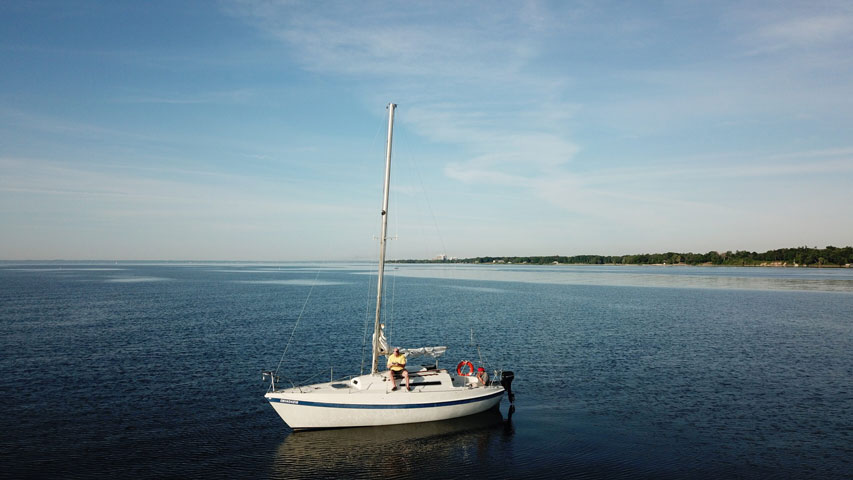
Memories of Sail Repairs, Replacement Sails and FINALLY New Sails
I have had a Tanzer 26 for over 20 years now. The vessel, without much imagination I call The Boat, has served me well and without complaint through yearly cruises on Lake Ontario with my three kids and day sailing with the wife. Did I mention that my wife is a good sport but a definitive lover of a good.

My Need for Cruising Speed Demands a Great Suit of Sails
My Need for Cruising Speed Demands a Great Suit of SailsI like to sail fast mostly in the heavy winds that Lake Ontario throws.
" * " indicates required fields
Thanks for telling us a bit about yourself and your boat. Our team will send you a preliminary quote based on information we have gathered from sailors similar to you.
We will give you a call in order to narrow down the options on your quote and improve the accuracy. If you want us to call you at a specific time, feel free to schedule a time on our calendar!
Thanks for telling us a bit about yourself and your boat. Our team will reach out to offer some suggestions and get started on finding you the perfect sail!

- CLASSIFIEDS
- NEWSLETTERS
- SUBMIT NEWS

A Rough Guide to Mainsail Reefing - by upffront.com
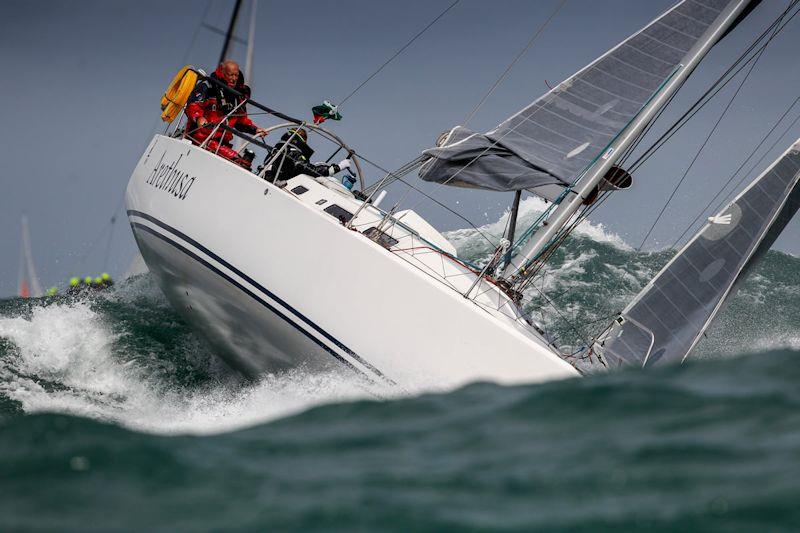
Related Articles
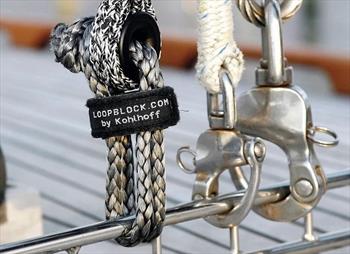
- New Sailboats
- Sailboats 21-30ft
- Sailboats 31-35ft
- Sailboats 36-40ft
- Sailboats Over 40ft
- Sailboats Under 21feet
- used_sailboats
- Apps and Computer Programs
- Communications
- Fishfinders
- Handheld Electronics
- Plotters MFDS Rradar
- Wind, Speed & Depth Instruments
- Anchoring Mooring
- Running Rigging
- Sails Canvas
- Standing Rigging
- Diesel Engines
- Off Grid Energy
- Cleaning Waxing
- DIY Projects
- Repair, Tools & Materials
- Spare Parts
- Tools & Gadgets
- Cabin Comfort
- Ventilation
- Footwear Apparel
- Foul Weather Gear
- Mailport & PS Advisor
- Inside Practical Sailor Blog
- Activate My Web Access
- Reset Password
- Customer Service

- Free Newsletter

Bristol Channel Cutter 28: Circumnavigator’s Choice

Hunter 35.5 Legend Used Boat Review

Pearson Rhodes 41/Rhodes Bounty II Used Sailboat Review
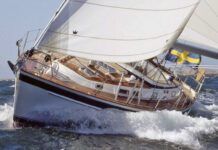
Hallberg-Rassy 42 Used Sailboat Review

Best Crimpers and Strippers for Fixing Marine Electrical Connectors

Thinking Through a Solar Power Installation

How Does the Gulf Stream Influence our Weather?

Can You Run a Marine Air-Conditioner on Battery Power?

Practical Sailor Classic: The Load on Your Rode

Anchor Rodes for Smaller Sailboats

Ground Tackle Inspection Tips

Shoe Goo II Excels for Quick Sail Repairs

Solutions for a Stinky Holding Tank

Diesel Performance Additives

What Oil Analysis Reveals About Your Engine

Hidden Maintenance Problems: Part 3 – Gremlins in the Electrics

Seepage or Flooding? How To Keep Water Out of the Boat

Painting a New Bootstripe Like a Pro

Alcohol Stoves— Swan Song or Rebirth?

Living Aboard with an Alcohol Stove

Choosing the Right Fuel for Your Alcohol Stove

Preparing Yourself for Solo Sailing

How to Select Crew for a Passage or Delivery

Preparing A Boat to Sail Solo

Re-sealing the Seams on Waterproof Fabrics

Waxing and Polishing Your Boat

Reducing Engine Room Noise

Tricks and Tips to Forming Do-it-yourself Rigging Terminals

Marine Toilet Maintenance Tips

Learning to Live with Plastic Boat Bits
- Sails, Rigging & Deck Gear
Reefing Preferences from the Pros
We surveyed a cadre of experienced delivery skippers from around north america to find out what systems and gear they favor for reefing mainsails, and to find out what they don't like, and why..
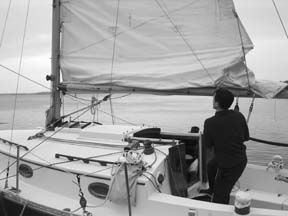
In our August 2011 mainsail buyers guide , we looked at all the decision points that go into buying a mainsail, including material, construction, slides, and reefing systems. This article takes a more focused look at mainsail reefing from the perspective of professional offshore sailors who have to deal with reefing every day.
When done properly, reefing the mainsail can be a graceful affair, a blend of art and science that keeps strong winds from tearing the sail to pieces while bringing relief to crewmembers who have been bouncing around on deck or in the cabin below. When a reefing line gets fouled or a halyard gets stuck or a block pulls out of the boom and colorful language comingles with the breeze, reefing the mainsail can become a high-seas calamity, and a certain precursor to unsafe situations.
High winds and building seas put a premium on equipment as well as crew expertise. Getting a proper reef tucked in means getting the boat back on its feet, and how effectively each component works alone-and within the reefing system-can mean the difference between an appropriately taut mainsail or a baggy foil with scalloped sags along the luff stressing the slugs or slides and a flogging clew that causes undue wear to both the sail and the reefing gear. All of this not only wreaks havoc on the gear and the boat’s performance, but also on its occupants’ safety and peace of mind.
To better understand what reefing systems work best, and what particular items of gear function and don’t function when the wind pipes up, Practical Sailor surveyed a cadre of professional delivery skippers for their insights.
Andrew Burton of Newport, RI, is like several of the skippers we queried. He has sailed all over the world, logging some 250,000 miles in the last 30 years on boats that have had everything from iron hoops to the latest mast track systems.
“The best way to reef is sailing dead down wind,” said Burton. “The boat is stable and less likely to be pitching around in the waves. For mast track hardware, I like the Harken and Antal equipment, they’re both fabulous, especially Harken’s Bat Car system for getting the main down and being able to reef it. The only area you have to watch out for in the Harken gear is the way the batten end is attached to the car; there’s a pin, sometimes an Allen screw going into a nylon nut that can vibrate loose. It only happened to me once, on a charter boat, and not one that was maintained to private standards. Offshore, if it hits the fan with a bolt-rope system, you’ll have a hell of a time getting the sail down; same goes for a roller-furling boom, you have to turn the boat into the wind to get the sail down.”
Stan Gauthier of Crew Service International in Vancouver Island, BC, takes the opposite stance regarding in-boom furling systems: “The top dog in my opinion is the Leisure Furl in-boom furler,” he told us. “It’s made in New Zealand and a really top-notch system.
“For jiffy reefing systems, the cheapest and most effective way to tame the main is The Dutchman. [The Dutchman uses a system of monofilament lines led from the foot of the sail, through bushings, upward to the leech. This keeps the sail in line with and on the boom when it is dropped. See PS June 1, 2000.] It’s economical and really works. As the main comes down, the sail stays in line. The main problem in reefing on a bigger boat is that the sail piles up and slops over one side of the boom. The Dutchman guides the sail all the way down and keeps it out of the way.
“For blocks, I prefer Harken. By and large, they stand up to punishment, although I have seen some give way. A lot depends on whether or not the blocks are used on a regular basis. If they’re not, they can be troublesome, as can traveler cars, which can stick and generally make life difficult.”
“My feeling is that simpler is better,” said Norman Connell of Bluewater Yacht Delivery, based in the Chesapeake Bay. “A lot of people are under the impression that if you have all the reefing lines led back to the cockpit, you’ll never have to go up on deck, but you end up having to go up there anyway, whether it’s to put the cringle on or untangle something. I’d rather do it at the mast.
“And a lot of people are afraid to reef the main so they wait too long to do it and that can lead to problems. Often people take a reef in their headsail before reefing their mainsail, and then you end up with too much weather helm.
“As far as single-line systems go, anytime there’s a line in the boom running on a block that’s inaccessible inside the boom, it’s just an accident waiting to happen. I prefer slab reefing with a cheek block on one side of the boom, everything led to the gooseneck, with a winch set on the mast for tightening the clew tension.
“As far as line clutches, I’m of the sort that dislikes most gadgets-they instill a false sense of confidence in what people can do. I prefer single arm cams on the boom for securing reeflines. Isomat makes their booms this way, as do other manufacturers.
I haven’t had any problems with The Dutchman system, but I do know some skippers who have had the lines shred; if you don’t have full-batten sails with really heavy battens, you don’t really need it. Ditto for lazy jack systems-if you have to head into the wind in really rough conditions just to get lazy jacks untangled, it’s just not a good trade-off.
“It’s been years since I’ve had any blocks fail on me, but I’m not out stressing the rig, going for that extra tenth of a knot. I sail conservatively and don’t try to break things.”
“Slab reefing and in-mast furling both have their merits,” said Bob Fritz of Compass Rose Yacht Delivery in Milwaukee, WI. “I’ve sailed somewhere near 7,000 miles on an Amel Super Marmu that had in-mast furling, and although I never had a problem with it, I come from a racing background and I found the mainsail shape troubling on that rig.
“The majority of boats I’ve sailed have had slab reefing, and it works well. There was one boat I delivered with a one-line system, and I didn’t like that too much-there was too much friction on the line as it runs through all the required blocks.
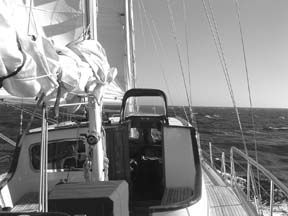
“I’ve used The Dutchman, which worked well to get the sail down and keep it contained. I’ve also used the StackPack, which I didnt like. It contains the sail when you drop it, but the battens have a tendency to get caught on the lazy jacks when raised. We were headed to Bermuda and had some pretty big winds and seas. When the wind dropped from 40 knots to 25, we tried to put the main back up, but had to turn into the wind and some big seas to get the sail up, and the battens kept getting caught. It was frustrating at the time, but humorous to look back on.
“I use Harken Air Blocks on my own boat, a Hinckley Pilot 35.As for line clutches, the early Spin Locks were a pain-they were hard to release and chewed up the line, but the modern ones work well.
“When setting up a boat for reefing, I prefer lines led to the mast or boom rather than aft to the cockpit, because you end up having to go up there anyway. Most of my experience with line clutches is with Spin Locks. They’re simple and reliable. I havent had any problems with shackles deforming, but I have had some open by accident if they get hung up on something just right.”
“Redundancy is the most important thing to a delivery skipper, said Jeremy Steele-Perkins of Ocean Captain’s Group, based in Canandaigua, NY. “I’ve reefed boats of all sizes with jiffy reefing, and used in-mast furlers with some others. With jiffy reefing, if a block pulls out of the boom or some other piece of hardware gives, theres a chance to jury rig it. With in-mast furling, things get more interesting.
“I’m a Harken devotee and have a preference for their blocks and gear. This is a first-class company and has an extremely good training program for their dealers. As far as rope clutches, I prefer these over cleats. With a clutch, should it fail, you can always use a cleat as a back-up, not so with a cleat. And most clutches have evolved over the past 10 years to be very reliable.
“When we get a boat for delivery, we survey it, but a lot of the gear is still an unknown until we put a load on it. Lazy jacks are nice to have, especially on larger, full-batten mainsails like those found on Freedoms, and this is what I have on my own boat. I’ve heard good things about The Dutchman, aesthetically it looks nicer than lazy jacks. The Stak-Pak is also very nice, and while this isn’t exactly what it was designed for, we once used it as a sail in 50 knots of wind.
“Generally, I prefer lines led aft to the cockpit on a boat. The less you have to go forward, the more elements of danger you’re avoiding. We usually sail with a crew of three, so the more that one person can do in the cockpit, the better for the rest of the crew.”
“New mainsail handling equipment seems to be a really good idea when the weather’s pleasant” notes Patrick Childress , who has delivered a lengthy list of boats and co-authored A Cruising Guide to Narragansett Bay and the South Coast of Massachusetts. “But as soon as the wind picks up, the more intricate such equipment is, the less likely it works well.
“Intricate mechanical systems like in-mast furling tend to bind at higher wind speeds, especially when you’re dealing with a big mainsail that rolls into a mast and must go in perfectly.
“As far as blocks, I go with whatever is there and don’t really have a preference for one manufacturer over another. One really good idea is to use a block on a reefing cringle, which eases friction on the metal eye.
“I prefer slab reefing, and used to be an everything-at-the-mast guy, but now with many boats you can reef pretty well from the cockpit. If I do have to go forward, I like to have ‘sissy bars’ to hang on to.
“As for securing reefing lines, it depends on where the line terminates. If it’s led back to the cockpit, I prefer a cleat, like a jam cleat with a breaking device to free the line.”
“The installation is everything,” noted Adam Smith , who occasionally works with Echo Yacht Deliveries of Newport, RI. “Keeping friction and chafe to a minimum is critical in how well a reefing system is going to work, regardless of whether it’s a single- or double-line system. I prefer roller bearing blocks that keep friction low and use Ronstan and Harken the most.
“As far as mainsail handling systems, the Stak-Pak does a nice job of collecting the sail and works well for quick hops, like between islands in the Caribbean. I’ve found it causes a little chafe on full-batten mains and I like to have extra webbing stitched over batten pockets to protect them.
“Regarding the components of a reefing system, I like sail-taming systems like the Doyle StackPack and The Dutchman, if they’re sturdy enough. Part of their appeal relates to how often you have to reef. In windy places like San Francisco Bay where sailors tend to reef pretty regularly, one is more likely to appreciate these systems.
“And about mainsail reefing layouts, I have some mixed feelings. The traditionalist in me says leave the controls at the mast, which is the way it is aboard my own Pearson 35, but being able to reef from the cockpit obviously has its advantages. Principally, it keeps people off the deck in nasty weather, but often you induce more friction in the system by running all the lines back to the cockpit.”
Capt. Bernie Weiss of Atlantic Yacht Deliveries in Stamford, CT, told us that he prefers to have deep reefs in the mainsail unless the boat is set up for racing. “I don’t believe in shallow reefs. On my own boat-a fractional-rigged Tartan 33-I have two reefs. The first one reduces the mainsail by 15 to 20 percent, and the second takes out roughly the same amount.
“It’s a slab reefing system, and all the controls are at the mast. The main halyard is made fast there, so everything is within arm’s reach when I get up there to reef. I’ve got a small, single-speed Lewmar winch mounted on the boom to achieve tension on the clew reefing line. In fact, all the winches on my boat are Lewmars, they’re just so simple to maintain and reliable. That one is 25 years old and it’s never given me a even a minute of trouble. The blocks I use are Schaefer and Nicro-Fico. Both are quality products at reasonable prices.
“I don’t use a reefing line for the tack, instead, I’ve had the cringles in the luff of the sail fitted with earrings-stainless steel rings that are connected through the cringle by webbing-and I simply slip those over the tack horns on the gooseneck. This system is very straightforward and simple. It doesn’t take me much longer than a minute or a minute and 15 seconds to tie in a reef. Of course it helps to have someone in the cockpit working the helm, mainsheet, and traveler.”
Weiss stressed that there are a lot of variables that should be taken into account before one decides on a reefing system and its components. “You have to know whether the boat is to be raced or cruised, whether the typical crew is experienced or still learning, as well as what prevailing wind and general weather conditions the boat will be sailing in. Likewise, things like dodgers, which can interfere with someone’s ability to fold the main, and mainsail fabric-whether it’s heavy and stiff or light and soft-are other important factors.
“Still, there are some general principles that apply to reefing mainsails. Reefing early, before it becomes absolutely necessary, helps. For example, if I’m sailing in the ocean through the night, even with excellent wind and sea conditions, I will typically reef the main before sunset to avoid having to do so in the dark. If sailing a tender boat short-handed, I may put in a reef before I leave the dock so that when I set the main at sea, it is pre-reefed. A forecast of foul weather will also prompt me to reef early.

“The system you know and are comfortable with-whichever one that happens to be-is the best system. When initially encountering a new or unfamiliar reefing system, I would suggest reefing the main a couple of times in good weather before facing any nasty weather. Be certain that the reefing system functions properly and that you know how to get the job done quickly and efficiently. This way you can work out the optimum sequence of maneuvers, which crew is to work at which winch with which lines, and all those other important details. Simple is better than complex. The fewer lines and less tackle-the minimum gear to get the job done-is what I prefer.”
Conclusions
In order to ensure that the information derived from this survey would be as representative as possible, the respondents were deliberately chosen using two criteria: the depth of their experience, and their varied geographic locations. Admittedly, the comments compiled don’t address every item of gear involved in the mainsail reefing systems that PS readers use, and many of our respondents’ remarks are general in nature. Still, it’s clear that this group of professionals favors systems that are cleanly laid out, and simple in nature over those that have inherent complexities. Essentially, they favor slab or jiffy reefing systems, and prefer those set up with two lines rather than one.
Surprisingly, most don’t feel it’s overly important to lead reefing lines and halyards back to the cockpit, a reflection of their leaning toward simplified systems. By general consensus, these sailors aren’t big fans of in-spar furling systems, whether in the boom or in the mast. Again, they told us that this is mostly due to the complex nature of these mechanisms relative to slab or jiffy reefing alternatives.
Regarding blocks, three out of the eight respondents prefer products from Harken Yacht Equipment; one mentioned Ronstan, and one Schaefer and Nicro-Fico. There was no clear consensus regarding rope clutches vs. cleats, but Spinlock was mentioned most often as a reliable product.
RELATED ARTICLES MORE FROM AUTHOR
Leave a reply cancel reply.
Log in to leave a comment
Latest Videos

C&C 40: What You Should Know | Boat Review

A Simple Solution for Boat Toilet Stink

An Italian Go Fast Sailboat – The Viko S 35 |...

What Is The Best Folding Bike For Your Sailboat?
- Privacy Policy
- Do Not Sell My Personal Information
- Online Account Activation
- Privacy Manager
- BOAT OF THE YEAR
- Newsletters
- Sailboat Reviews
- Boating Safety
- Sailing Totem
- Charter Resources
- Destinations
- Galley Recipes
- Living Aboard
- Sails and Rigging
- Maintenance

Seamanship 101: Reefing the Main
- By Bruce Bingham
- Updated: May 20, 2015
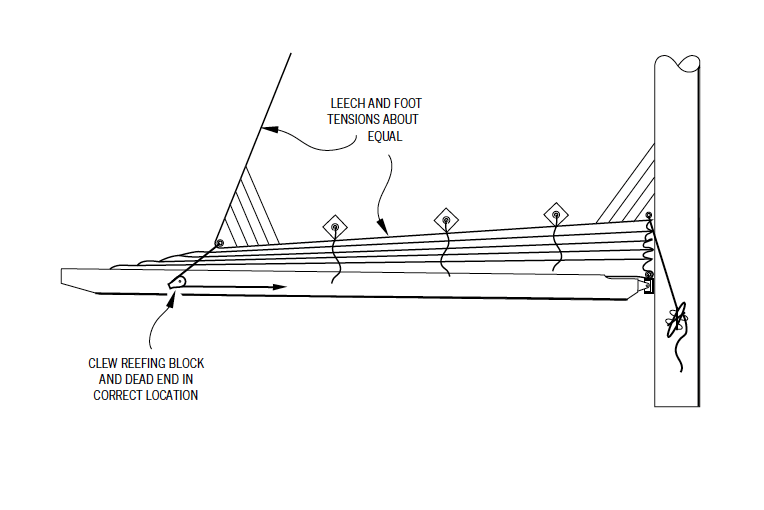
A few years back, on a gusty day with winds over 40 knots, my 34-year-old Cape Dory 28, Nikki — a cruising boat I live aboard — won the coveted Michelob Cup on Florida’s Tampa Bay, topping a fleet of more than 40 other yachts, most of which were hard-core raceboats. Not coincidentally, Nikki’s crew had trained in heavy weather and could reef the mainsail in 40 seconds or less, and shake it out even quicker.
Nobody in Tampa Bay racing circles had ever seen or competed against Nikki . She was the oldest and smallest boat to race that day. Though we were later accused of cheating by a disgruntled opponent (and quickly exonerated), Nikki continued her winning ways and was later named Southwest Florida’s Cruising Boat of the Year by the West Florida PHRF Racing Association. Proficient and rapid reefing remained a key to our success. In fact, unlike many of our competitors, we always hoped for strong winds on race days.
Of course, there are lots of reasons to reef that are more important than winning races. Well-executed, timely reefing has a positive impact on your boat’s performance and safety in heavy weather. A well-balanced sail plan also keeps your crew and passengers safer and able to move about more comfortably, increasing their level of confidence in your sailing abilities and attention to their welfare. There’s nothing that will ruin a day on the water faster than a partner or friend screaming, “We’re tipping over!”
Here are a few more ways reefing promotes better sailing:
- Keeps the boat “on its feet” and more efficient in terms of hydrodynamics and aerodynamics.
- Increases speed potential in rough conditions.
- Reduces adverse weather helm (unnecessary drag).
- Dramatically reduces leeway when pointing and close-reaching.
- Reduces wear and tear on sails and equipment.
- Makes sails easier to trim and handle.
Setup and Sequences
It’s important that all the hardware and running rigging for reefing maneuvers are close at hand. For a classic plastic cruiser like Nikki , the reefing-control gear — the bitter ends of the reefing tack and clew lines and their respective cleats or clutches — should be situated on the same side of the mast and/or boom as the main halyard winch (usually on the starboard side). On more contemporary cruising boats, this gear is often led aft to the coachroof, flanking the companionway. The main topping lift should also be readily close by. This way, the crew tucking in the reef needn’t move from one side of the boat to the other to complete the task. Topping lifts and clew lines should never terminate at or near the end of the boom; these would potentially require the crew to hang dangerously over the lifelines to access them.
Because they’re quickly made, saving valuable time, I prefer cam or clam cleats for all reefing control lines. On the boom, reefing clew lines are best installed internally to keep the spar uncluttered. Alternatively, these clew lines can be routed through three or four small strapeyes that are machine-screwed to the boom.
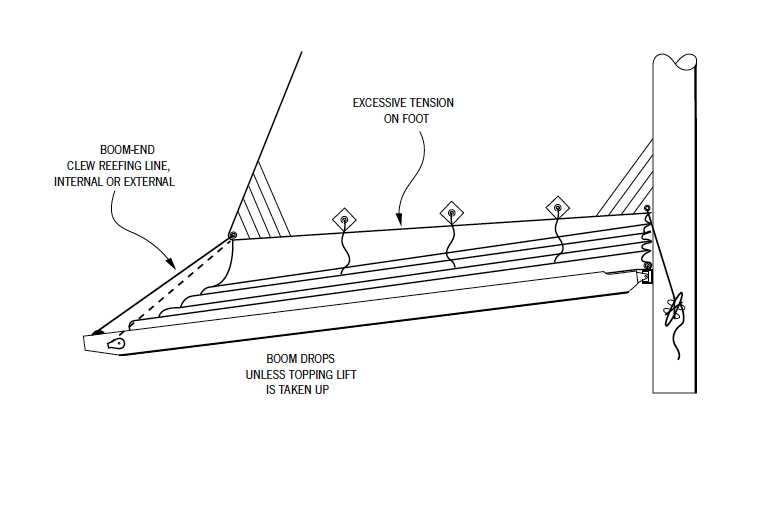
Many booms are equipped with reefing tack hooks integral with the gooseneck; others have dedicated tack lines. Nikki has both, and I’ve found that the tack line is much faster to use, saving precious seconds.
Whether you sail a sloop, cutter, yawl or ketch, the traditional jiffy- or slab-reefing sequence is virtually universal. Practice it with your crew until reefing becomes a streamlined and habitual process. Eliminate confusion, yelling and mistakes. The job should be smooth and rapid. The following is the correct sequence for all boats that do not employ a single-line system (more on those in a moment). On Nikki I’ve actually printed out and laminated two copies of these instructions, and taped one to the mast and the other in the cockpit.
Here’s the drill:
- Ease the boom vang and then the mainsheet so both are slack.
- Take up the topping lift so the boom is stabilized.
- Lower the main halyard until the desired reefing tack cringle is in position.
- Tighten and make fast the reefing tack line, or put the tack cringle onto the gooseneck hook, ring or shackle.
- Hoist the main halyard until the luff is firm and wrinkle-free.
- Take in the reefing clew line, or luff cringle, via a boom winch or tackle as much as possible, and make fast.
- Ease the main topping lift.
- Trim the mainsheet.
- Tighten the boom vang.
Personally, I find this slab-reefing system, with separate controls for the leech and luff of the sail, to be preferable to single-line reefing systems. First, due to the friction and loads caused by a single-line system running through multiple sheaves and leads before terminating in the cockpit, those sheaves are not timesavers. Also, because the reefing line is so long, it may develop kinks in the line that delay the maneuver until they’re straightened out. Finally, single-line reefs eliminate the ability to adjust sail draft and leech tension separately.
So now that your sail is reefed, what do you do with the lowered panels of the sail that are no longer set? On Nikki , I use dedicated buntlines: small-diameter lengths of line that pass through a horizontal series of cringles in the sail, between the reefed tack and the reefed clew, and tied with reef knots. Their only purpose is to store the “bunt” — that excess sailcloth that hangs down from the finished reef — to increase visibility from the helm and reduce flopping. For mainsails without buntlines, the sail can be gathered and secured with sail ties rove through the appropriate reef points, or through cringles in the sail, which serve the same purpose. Either way, buntlines or sail ties should never be pulled tight before tying, because they will strain and eventually tear the sail at the cringles. Your reefed sail should be left loose-footed, although the buntlines or ties can be knotted under the boom or only around the bunt itself, which I prefer. When I race Nikki, I leave the bunt untied because it doesn’t get in the way and it reduces the time to take another reef in or shake it out.
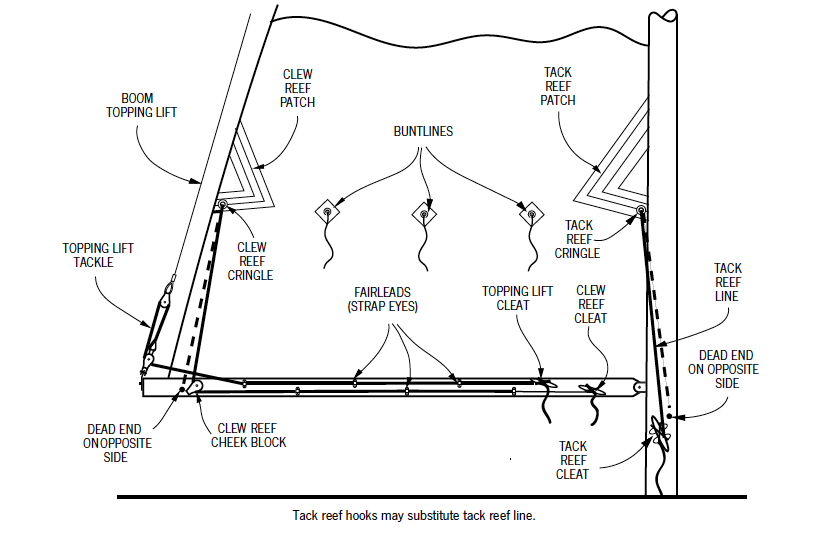
Over the years, I’ve heard some sailors say they don’t know how or when to reef, justifying this confession by stating that they don’t sail when it’s too breezy, or they simply bear away as the wind stiffens. This is shortsighted and even dangerous, for the day will come when you’re caught in a rising squall or changing weather, and there are few choices or tactics other than reducing sail.
So practice with your family and regular crewmembers, and you’ll soon discover how easy reefing really is. Keep a stopwatch handy and try to beat your best time. This skill will broaden your sailing horizons and increase your self-reliance dramatically as you discover what you and your boat are capable of when conditions deteriorate.
Learning to reef quickly will also teach you what needs to be corrected or modified on your boat to make reefing more effective and convenient. Boat manufacturers are not necessarily heavy-weather sailors and often take shortcuts. What they install is not always ideal in terms of hardware or deck layouts.
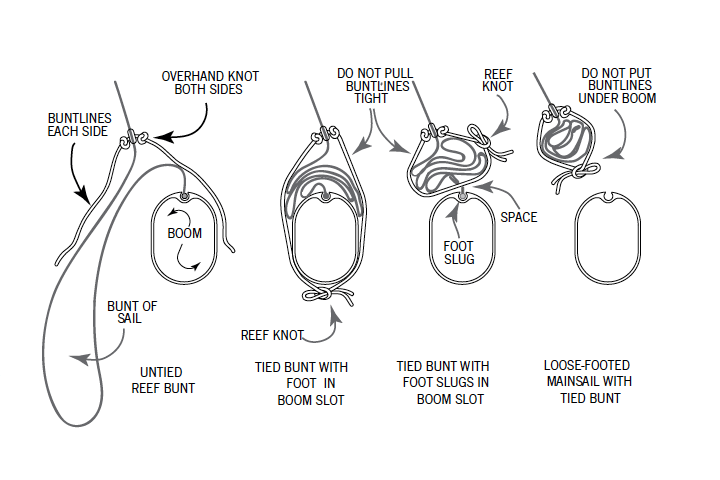
In my experience, sailmakers, mast and boom assemblers, and yacht designers aren’t always on the same page either, and the result can be reefing systems that just don’t work.
So let’s delve a bit deeper and focus on some of the finer points of the design and installation of reefing hardware.
End-Boom Dilemmas
If you have a boom with an internal reefing system — with sheaves for the clew(s) installed at the outboard end of the boom — you’ve probably ascertained that something wasn’t right when you tried to set a reef. Most likely, your boom drooped to an odd angle and may even have ended up on top of your bimini or dodger. If your boom has external clew reef lines with cheek blocks and dead-end padeyes installed at the end of the boom, the same thing will happen.
To make matters worse, if the clew reef lines are led to cleats that are also near the end of the boom, you can’t reach them unless you are either sheeted in and sailing to weather or luffing head to wind.
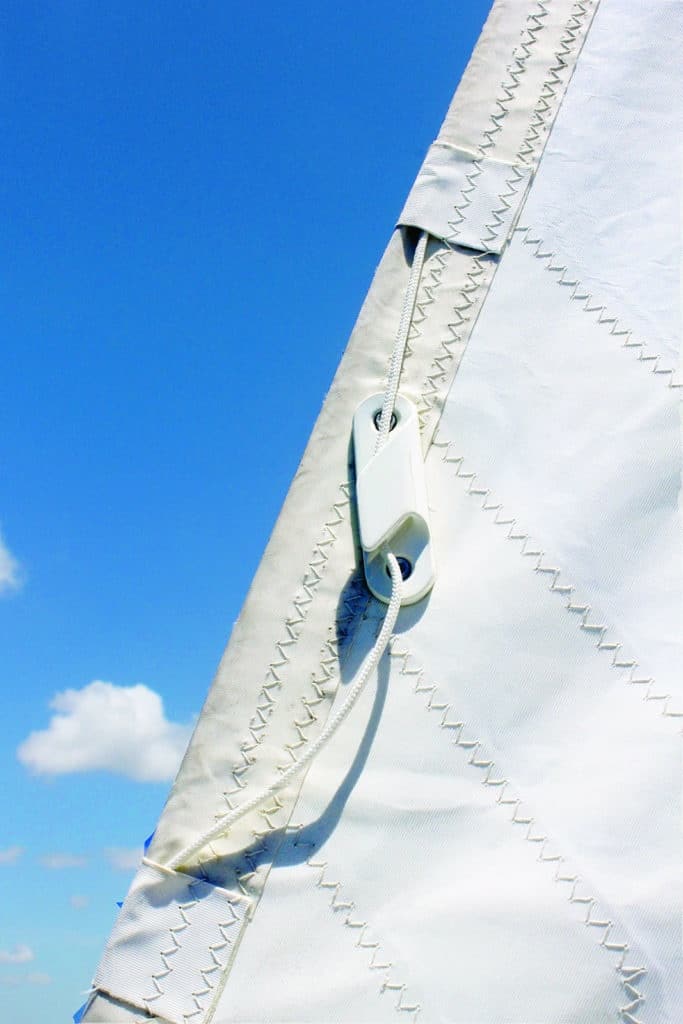
Clew reefing lines emanating from the end of the boom are not only inefficient; they can be hazardous for anyone who has to make them up while hanging over a lifeline or under a thrashing boom.
In other words, there’s really no excuse for this system on a well-found cruising boat.
The angle of that clew line, when reefed, is a related issue. When a mainsail is reefed, it essentially becomes a loose-footed sail (even if the actual foot of the sail is slotted into the boom). A reefed sail’s draft and twist control is not unlike a headsail’s; in other words, the angle of the jib or genoa sheet and the angle of the clew reefing lines determine the sail’s twist, while the tension on these respective lines controls the draft. So it is vital that the position of the clew reefing hardware is correct, and this is easily determined.
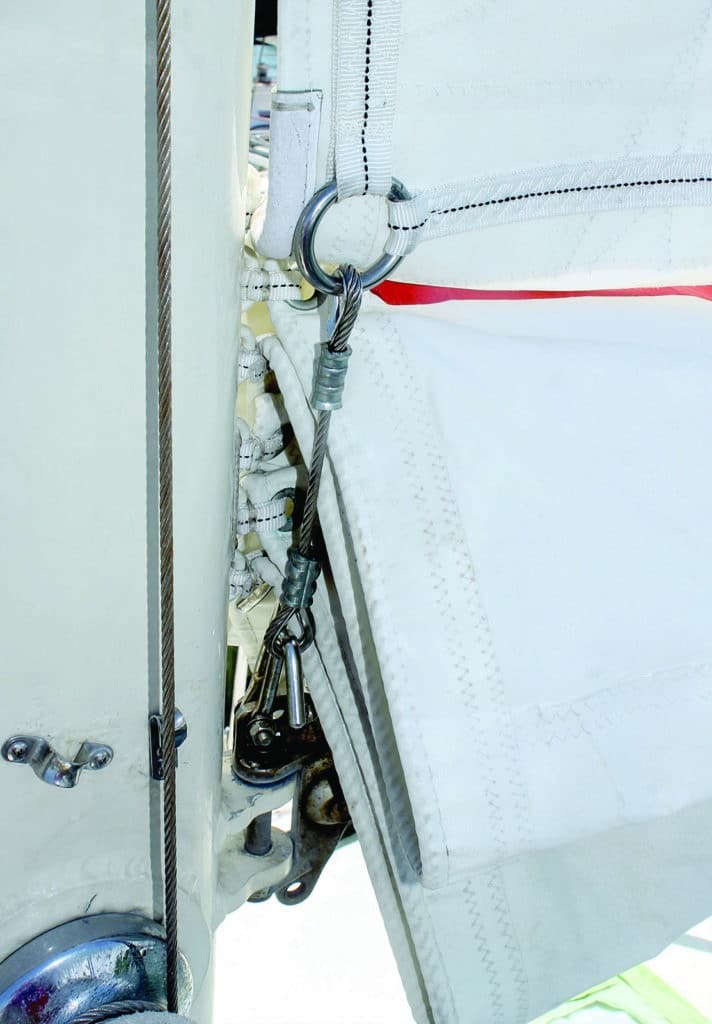
With your mainsail lowered to its reefed position and the new tack placed into its reef hook (or, similarly, with the tack reefing line taut and made fast), pull on the clew reefing lines and manually change their angle. When you pull downward, hard, the sail’s leech tightens and its twist is reduced, while the foot of the sail loosens and develops more draft. Likewise, when you yank the clew reef line upward, the foot of the sail becomes tighter and flatter, while the leech loosens and develops more twist.
Ideally, you want to strike a balance so the leech and foot tensions are about the same. The angle for this clew reef line might not be perfect for all points of sail, but you will need to reef most often when sailing to weather, so I recommend adjusting the clew hardware accordingly.
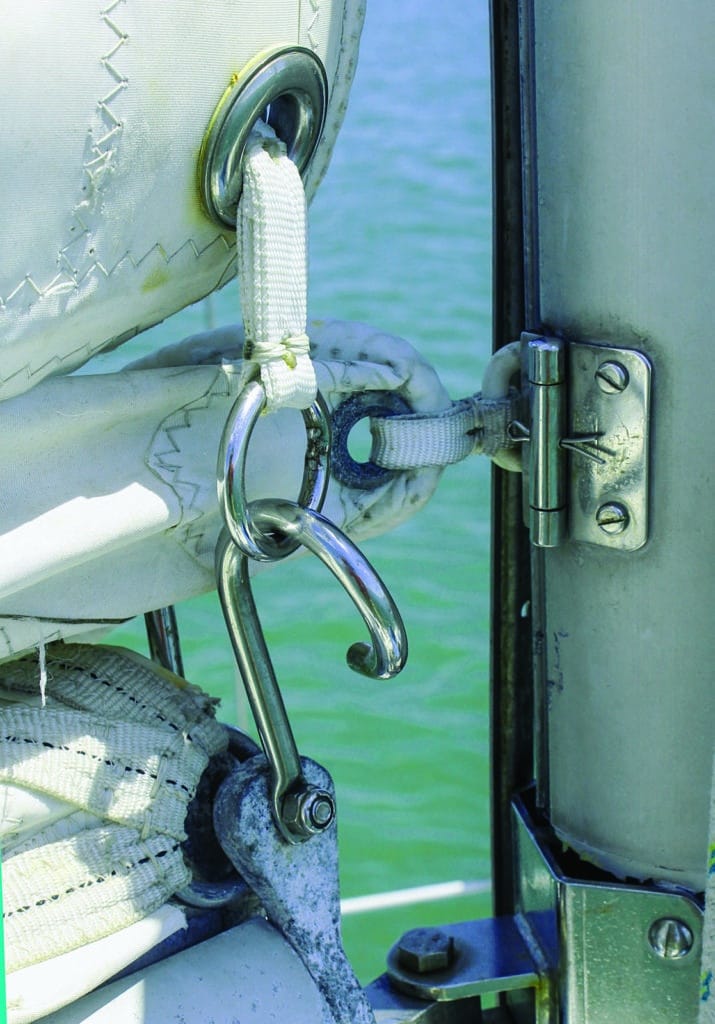
Many older boats have the cheek block for the reefing clew on a track so small adjustments can be made to accommodate changing wind velocities and points of sail. If you want to split hairs, a block on a track is the way to go. Clew reefing hardware at the end of the boom will never result in a reefed sail that is well trimmed.
Tacks and Leeches
When reefing a mainsail, the first reef-point connection to make is the tack cringle. But this can be difficult if the sailmaker has not made adequate accommodation for the stacked-up luff on the mast that occurs when lowering the sail.
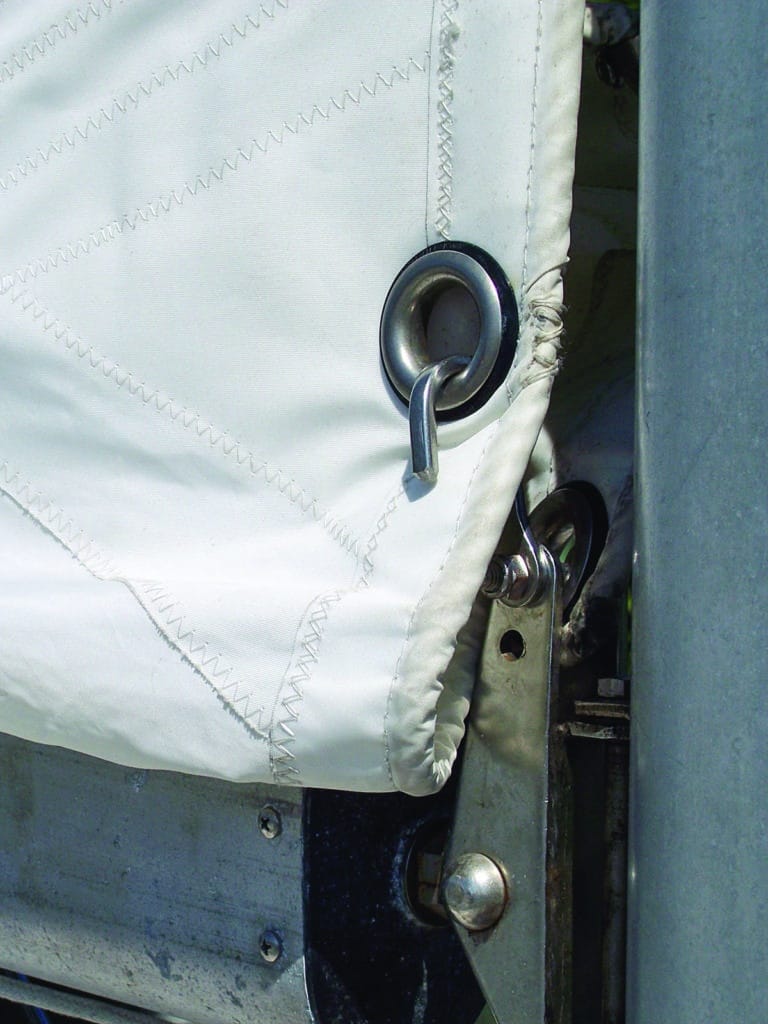
If you are using reefing tack hooks, a major problem can occur if there is a slug-entry closure in the mast that prevents the luff from dropping fully to the gooseneck. A ring pendant may be added to the reefing tack cringle so the tack hook can be reached. Cringles for second or third reefs will also require pendant extensions.
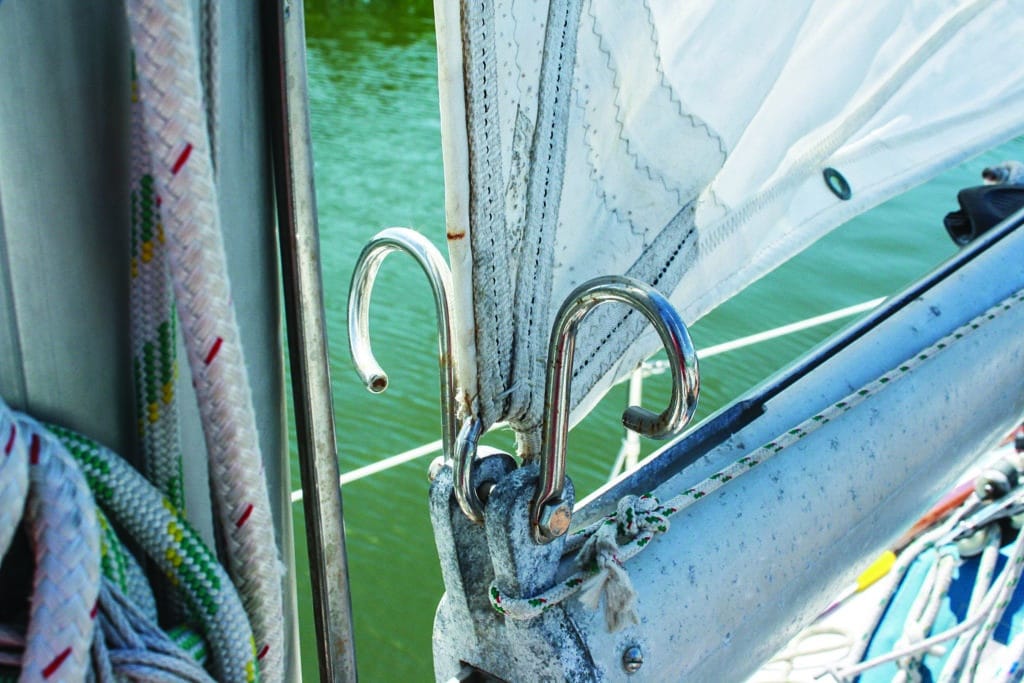
If your mainsail is set up with reefing tack lines, rather than gooseneck hooks, the problem of sail stacking is greatly reduced. But the height of the reefed tack position still causes distortion with the sail. My recommendation is to close the slug entry with a semipermanent cover that will allow the sail stack to be much lower. If using tack reef hooks, you’ll still use extension pendants, but that stack will be much shorter.
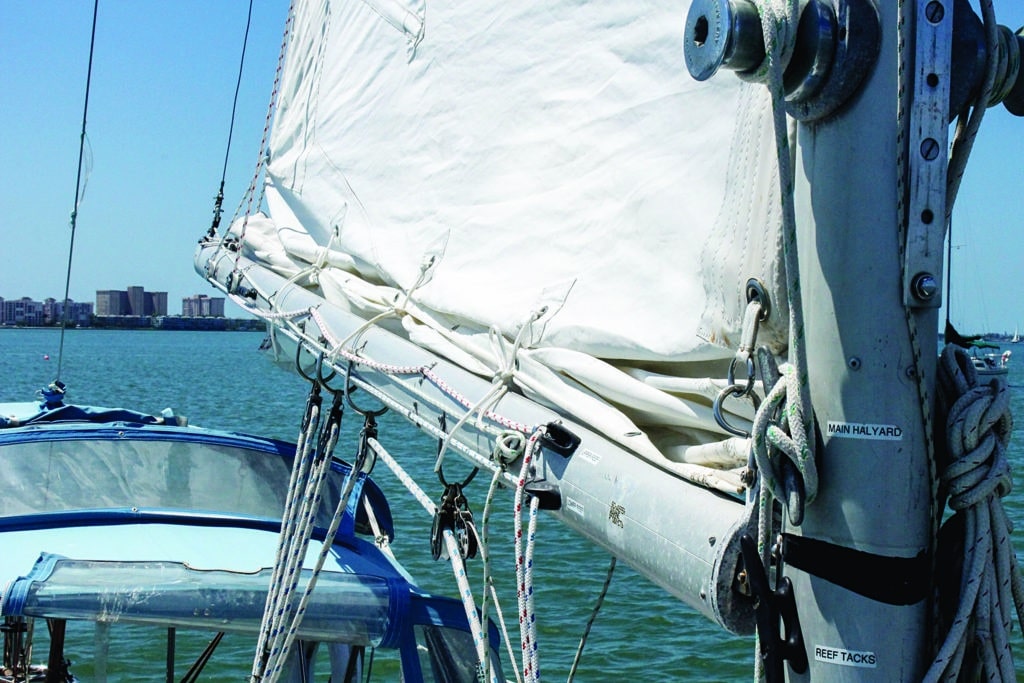
Along the trailing edge of the main, chances are that your sail has a small-diameter leech line that begins at the head of the sail and extends all the way to the foot. The leech line exits the leech hem through small cringles just above the boom and at the respective patches for each reefing clew. A small cleat will be situated at each reef point. Once a reef is tied in, you should apply just enough tension on the leech line to stop any flapping or movement of the sail’s leech, and then make it fast. When shaking out a reef and before you fully hoist the main, always remember to slack those leech lines to prevent a series of distinct hooks in the sail. Not only do they look bad, they’re also inefficient.
Boatbuilder, naval architect, author, illustrator, marine surveyor and long-time CW *contributor Bruce Bingham is also the proprietor of Bruce Does Boatwork, a yacht repair and refit business in St. Petersburg, Florida. *
- More: How To , reefing , seamanship
- More How To
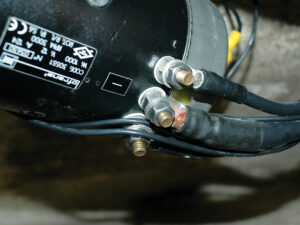
How to Keep Your Windlass Working For You
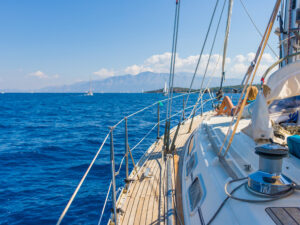
Southern Comfort: Tactical Tips for Sailing South

Preparing to Head Out
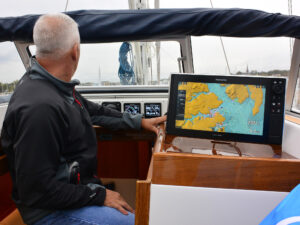
Adding Onboard Electronics? Here’s How To Get Started
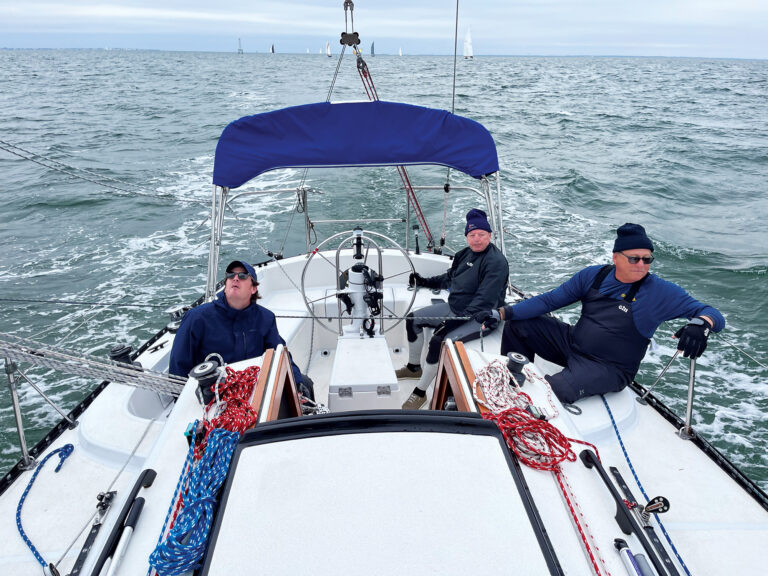
The Re-creation: My Day at the St. Pete Regatta
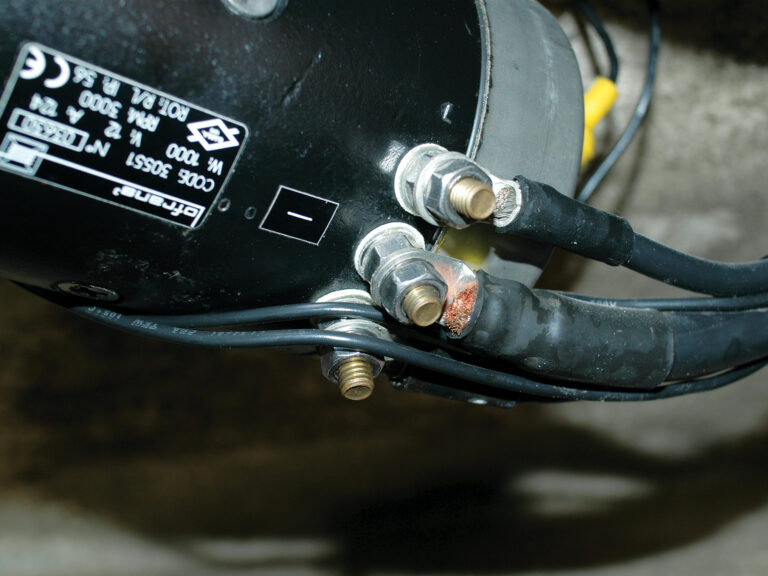
Musto’s MPX Impact is Made for Offshore
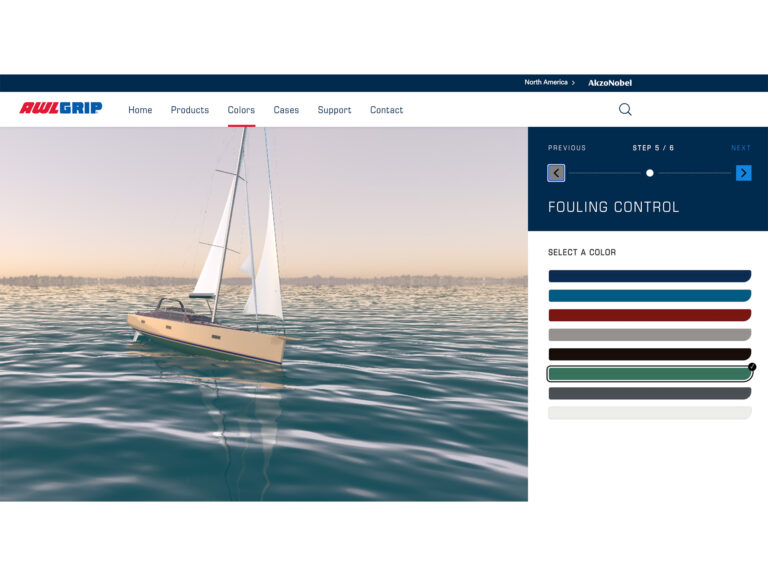
Awlgrip Unveils 3D Color Visualizer
- Digital Edition
- Customer Service
- Privacy Policy
- Email Newsletters
- Cruising World
- Sailing World
- Salt Water Sportsman
- Sport Fishing
- Wakeboarding
- Reefing: A Sailing Technique to Navigate Rough Waters
Sailing has been a timeless pursuit for adventurers and enthusiasts alike, providing a unique way to harness the power of the wind and explore the open waters. However, mastering the art of sailing involves understanding various techniques, and one such technique that's crucial for safe and efficient sailing is reefing. In this comprehensive guide, we will delve into the world of reefing, exploring its definition, its importance, and how to execute it effectively.
What is Reefing?
Reefing is a fundamental sailing maneuver used to reduce the sail area exposed to the wind, primarily in response to changing weather conditions. It's a technique that every sailor should have in their arsenal, as it ensures the boat remains under control during strong winds and prevents it from becoming overpowered.
The Importance of Reefing
1. safety first.
Reefing plays a pivotal role in ensuring the safety of the crew and the vessel. When the wind picks up unexpectedly, failing to reef can result in an overpowered boat, making it difficult to handle. This can lead to accidents and damage to the sail, rigging, or even the boat itself.
2. Maintaining Control
By reducing the sail area, reefing allows the sailors to maintain better control over the boat, even in adverse conditions. This control is crucial for avoiding capsizing or getting caught in dangerous situations.
3. Extending Sail Life
Reefing also helps extend the lifespan of your sails. Sails that are constantly exposed to high winds can deteriorate quickly, leading to costly replacements. By reefing when necessary, you can protect your sails and your wallet.

How to Reef a Sail
Step 1: prepare your crew.
Before reefing, communicate with your crew and ensure everyone is aware of the plan. Safety should always be the top priority.
Step 2: Assess the Conditions
Keep a close eye on the weather conditions. Signs of strong winds approaching, such as dark clouds or white-capped waves, should trigger the decision to reef.
Step 3: Head Into the Wind
Turn your boat into the wind to depower the sails. This will make reefing safer and more manageable.
Step 4: Lower the Sail
Lower the sail partially to reduce the exposed sail area. Be sure to secure the sail ties to keep the sail tidy.
Step 5: Adjust the Tension
Check and adjust the tension of the reefing lines to ensure that the sail is properly secured in its reduced state.
Step 6: Resume Sailing
Once the sail is reefed, you can resume sailing with better control and confidence.
Overpowered Boat: Risks and Solutions
An overpowered boat is a common issue when reefing is neglected. This occurs when the sail area is too large for the current wind conditions, leading to instability and reduced maneuverability. To avoid this, reefing is essential. It's a simple yet effective solution that can prevent a host of problems, including capsizing and damage to the boat.
Used Sails in California
If you're looking to purchase sails or find expert advice on reefing in California, you're in luck. The sunny state is home to numerous sailing enthusiasts and shops that offer a wide range of used sails. These cost-effective alternatives can help you get started on your sailing journey without breaking the bank.
Reefing Sails: A Detailed Guide
1. understanding reefing lines.
Reefing lines are essential for controlling the reefing process. Learn how to properly set up and adjust these lines for maximum effectiveness.
2. The Role of Sail Slides
Sail slides are small fittings that help secure the sail to the mast. Discover their importance in reefing and how to maintain them.
3. Practice Makes Perfect
Mastering the art of reefing takes practice. Explore tips and techniques for honing your reefing skills in various wind conditions.
4. Reefing on Different Types of Boats
Different types of sailboats may require slightly different reefing techniques. Gain insights into reefing on monohulls, catamarans, and more.
Read our top notch articles on topics such as sailing, sailing tips and destinations in our Magazine .
Check out our latest sailing content:
Fishing and sailing: where to sail for the best catches?
Skippered boats: how to pack for a cruise?
Boat rental with skipper: everyone can go to sea!
Skippered boats: myths about sailing
Sail from Lefkada for 14 days. Where to?
What not to miss when visiting Lefkada
Skippered boats: step by step boat rental
Where and why to sail from Lefkas marina
Don’t panic: handling maritime emergencies
Skippered boats: which boat to choose?
The best sailing routes from Biograd na Moru
Yachting Away from Ourselves: A Voyage to Inner Peace
Sail to the 7 most beautiful sights in Greece
Skippered boats: how to build a crew
Skippered boats: the most popular cruise destinations
What skipper's licence do I need?
Skippered boats: what else to experience on a cruise
From Lefkada or Corfu to Paxos and Antipaxos
Discover the paradise of Paxos and Antipaxoss
Skippered boats: a typical day on a boat
Skippered boats: what it looks like on a boat
Discover Corfu: sailing adventure in the Ionian
Sextant and navigation: survival without GPS
5 best sailing routes in the Bahamas
Skippered boats: how much does a boat holiday cost?
Yachting guide to the Bahamas
The ultimate yacht cleaning kit
Introduction to chartering with a skipper
Traditional sailor tattoos: Meaning of the swallow
The most popular catamarans of 2023
Reefing vs. Furling: What's the Difference?
While both reefing and furling reduce sail area, they are distinct techniques. Learn the differences between the two and when to use each method.
The Science of Sail Shape
Understanding sail shape is crucial for effective reefing. Dive into the physics of sail shape and how it impacts your sailing experience.
Reefing Safety Tips
Safety should always be a priority when sailing. Explore a comprehensive list of safety tips to keep in mind when reefing and sailing in general.
Common Mistakes to Avoid
Even experienced sailors can make mistakes when reefing. Discover common errors and how to avoid them for a smoother sailing experience.
Advanced Reefing Techniques
For seasoned sailors, advanced reefing techniques can offer greater control and performance. Explore techniques like slab reefing and single-line reefing.
Exploring the World of Sailing
Sailing isn't just about mastering techniques like reefing; it's about exploring the world. Whether you're cruising along the coastlines or embarking on an oceanic adventure, sailing allows you to connect with nature in a profound way. From witnessing breathtaking sunsets on the water to encountering diverse marine life, every voyage is a unique experience.
The Joy of Racing
For those with a competitive spirit, sailing offers an exhilarating avenue through regattas and races. Competing against fellow sailors not only sharpens your sailing skills but also fosters a strong sense of camaraderie. Racing adds an extra layer of excitement to the sailing world and is a fantastic way to meet like-minded individuals.
Navigating Uncharted Waters
Sailing is more than just a sport; it's a journey of self-discovery. Navigating uncharted waters, facing unpredictable weather, and overcoming challenges on the sea can teach valuable life lessons. You'll learn to adapt, problem-solve, and make quick decisions – skills that can be applied to various aspects of life.
The Serenity of Solo Sailing
While sailing is often a communal activity, solo sailing is a unique experience cherished by many. It's a time for self-reflection, introspection, and complete immersion in the elements. Solo sailors find solace in the rhythmic sound of waves and the whisper of the wind, forging a deep connection with the sea.
Sustainable Sailing
With environmental concerns on the rise, sailing is increasingly embracing sustainability. Many sailors are adopting eco-friendly practices, such as using solar panels, wind turbines, and even hydro-generators to reduce their carbon footprint. Sailing can serve as a model for sustainable living, demonstrating how to harness nature's power responsibly.
Sailing Destinations Worldwide
The world is your oyster when it comes to sailing destinations. From the turquoise waters of the Caribbean to the rugged beauty of the Mediterranean, there's a sailing paradise for every preference. Explore new cultures, cuisines, and landscapes as you sail to different corners of the globe.
Sailing for All Ages
Sailing is a sport that transcends age. Whether you're a young sailor starting your journey or a seasoned mariner with decades of experience, there's always something new to discover. Many sailing clubs offer programs for youth, ensuring that the tradition continues to flourish.
Sailing as a Lifestyle
For some, sailing isn't just a hobby; it's a lifestyle. Living aboard a sailboat, even part-time, offers a unique way of life, combining adventure with simplicity. Many individuals and families choose to live on the water, fostering a strong sense of community among fellow liveaboards.
In the world of sailing, mastering the technique of reefing is not just a skill; it's a necessity. It ensures your safety, the longevity of your sails, and the overall enjoyment of your sailing adventures. Remember, when the winds pick up, don't hesitate to reef and take control of your sailing destiny..
So what are you waiting for? Take a look at our range of charter boats and head to some of our favourite sailing destinations.
I am ready to help you with booking a boat for your dream vacation. Contact me.

Denisa Nguyenová

- Boats & Gear
- Instructional
- Cruising Stories
- Cruising Destinations
- Race Results
- Race Reports
- Racing Technique
- Submit a Classified Ad
- Boats for Sale
- All Classifieds
- Terms & Conditions
- Your Dashboard
- Seattle Area Racing Calendar (SARC)
- 48° North Cruising Rally
- Croatia Flotilla
- How To: Smooth Reefing for Smooth Sailing
- Seamanship & Navigation
From the January 2021 issue of 48° North .
Winter winds are here! It’s something to celebrate, but also something that requires special readiness. Being able to reduce sail to maintain better control of the boat is, of course, always important. This is especially crucial at this time of year.
Let’s zoom out, first. Boats are designed to sail best at a particular angle of heel — depending on the boat, somewhere between 10° and 20°. If the force of the wind on the sails causes the boat to heel more than that, it not only makes it harder to control and puts unnecessary strain on the rigging and the crew, but it is almost always a slower way to sail.
Reefing — the act of reducing the effective sail area to reduce the force the wind can apply to the boat — is one way to address this. Conventional wisdom offers the general rule: “If you are wondering if you should reef, you should already have a reef in.”
However, when and how to reef leaves lots of room for interpretation. Below, we will review some of the different kinds of reefing and how to make them work for you, your crew, and your boat during a particularly windy winter sail.
Before you get to tucking a reef in, remember that the first way to depower a sail is with the sail controls; and weather helm can guide you in this process. A few principles apply to this line of thinking:
A flatter sail has less power than one with more shape. Tightening the halyard, cunningham, outhaul, or the sheet and/or moving the traveler to leeward or headsail fairleads aft can all flatten and depower the sails. If your boat has an adjustable backstay, trimming the backstay on also flattens both main and jib.
All these sail controls will affect weather helm, which is the tendency of the boat to want to round up into the wind when it is overpowered. You always want a little weather helm, as keeping the bow from coming up creates lift to windward. It is also much safer for the boat to want to go bow-to-wind if you let go of the helm. As the wind increases so does the weather helm, so if it gets to be too much you will not be able to keep the bow down and/or will have to have the rudder so far over that it acts as a brake and slows the boat down. If sail controls are tight and you’re still struggling with excessive heel, a lot of weather helm, or both, it’s past time to reef. Remember, reefing when you first think about it is the best practice.
Reefing Approaches
Most often, when sailors think of reefing, they’re thinking of shortening the main first sail using a reefing system like Hook and Cringle. This is not the only option, but here are some considerations:
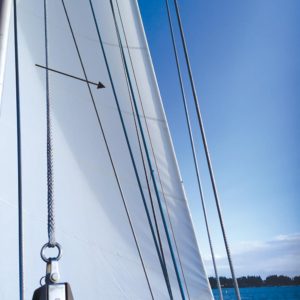
Roller Reefing: With furlers for roller furling headsails, in-boom and in-mast furling mainsails, we can shorten the sail by simply rolling it up on the furler. Unfortunately, these can be the most expensive reefing systems and the least effective, depending on execution. They are the most complicated and, by extension, the least reliable. However, they certainly have their advantages and can be well executed in their design, installation, and use.
The biggest problem with roller reefing is related to sail design. The designed draft (depth) in the middle of the sail dictates that, as the sail is rolled up, the edges of the sail roll proportionately faster than the middle of the sail (where the draft leaves more material). The resulting sail shape when partially rolled thus involves very tight sail edges while leaving the maximum draft area in the middle of the sail loose and baggy (Figure 1). This is exactly what you don’t want, because a loose sail with a lot of shape has more power and/or drag than a flat sail — resulting in poor upwind performance, more heel, and less control.
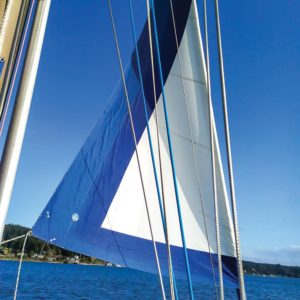
There are some clever designs to help with this problem. Lengths of foam sewn into the luff can help roll the sail more tightly and evenly for a better shape; and in-boom furlers are normally thicker in the middle to compensate for sail shape as the sail rolls up (as opposed to a simple straight bar). Another option is to roll the sail up so small that it is flat because the end of the sail has very little shape to it (Figure 2). With a headsail, the best way to shorten sail may be to take down the larger sail designed for light air, and put up a smaller one designed for heavier wind.
Slab Reefing: Slab Reefing, also known as Jiffy reefing (Figure 3), is the most common form of reefing you’ll see on sailboats with traditional mainsails these days. This involves having reef points on the sail that can form the new tack and clew when it is lowered, so that a slab of the sail is no longer used below the reef points.
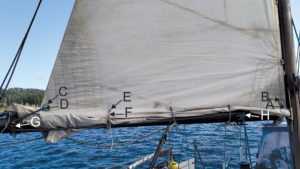
Hook and Cringle Reefing: Hook and cringle reefing is one of the simplest ways to secure this new tack. A hook is typically integral to the boom near the gooseneck and a sailor must go forward to attach the sail’s reef-point cringle to this fixed hook. The clew is then secured with a reefing line, usually rigged through the aft end of the boom, that thus becomes the new outhaul.
Two Line Reefing: The reef points on the sail used in slab reefing can also be secured each with their own lines (Figure 4). To reef, lower the sail to below the reef you wish to put in, tighten each reefing line to the proper tightness, then raise the halyard to tension the sail against the new tack and clew. Generally, each of these lines is run prior to sailing and is ready to employ from the cockpit. One way to save on reefing lines when using the two-line system is to have the cunningham attached to the sail by a hook (which could be used similarly to a fixed hook at the reefing cringle). While more efficient in terms of lines, it requires someone to go forward to attach the sail to the hook at its reef point, negating one of the benefits of a dedicated two-line system.

Single Line Reefing: This method works very much like two line reefing, except that one line is run through both reef points (Figure 5) and then only that line is tightened to secure the reef. This can be the simplest system to put a reef in, but can be one of the more problematic to get to work smoothly because it may have a lot of friction.
For the most part you can change your reefing system from one to the other as it suits your needs. If you don’t have in-mast or in-boom furling mainsail, roller reefing the main probably requires a new mast or boom … no small or cost-effective undertaking. But for the rest, they work similarly enough that they can be changed one for another. But why would you want to? Well, each sailor may want to identify their personal preferences in balancing ease, safety, and effectiveness. You want the reef to be easy to put in and shake out. It is almost always easier to shake a reef out than to put one in — hence the saying “reef early and often.” Many sailors would like to avoid going forward to put the reef in, if possible. Reefing setups altered to run all the lines back to the cockpit for easy employment may necessitate new lines, since existing lines may not have the length to work in this system.

Ultimately, each of these systems has advantages and disadvantages. Hook and cringle is the simplest option as far as moving parts and friction: cringle goes over hook, re-tension the halyard, then tension the reefing line (probably with a winch mounted on the mast or boom), and you’re done. With two-line reefing, you can lead both reefing lines and the halyard back to the cockpit and do everything from there. This will require several more blocks, which will add friction, plus the attachment and lead points for the tack reefing line need to be properly placed. With some careful rigging and friction management, a single-line system may work even more easily.
Friction is a big factor in whether any system works smoothly for you. Low-friction ball bearing blocks and low-friction rings properly placed and used can help reduce the total friction by quite a bit, but also remember to keep them well lubricated.
Reefing is one of those step-by-step procedures where, when it is really needed, it is likely to be done in less-than-ideal conditions. Going through each and every step and seeing if it can be improved is the only way to make it as smooth as possible. Practice at the dock, time yourself, get some friends to compete with to see who can do it the fastest; and then see why and if there is a way to improve it. All systems involve compromises, and experience is the only way to know what will work best for you, your boat, and crew.
And don’t forget, you are a part of that system. The best reefing system for your boat is the one where you can put a reef in quickly, safely, and effectively, no matter how cold and strong the winter winds may blow.
Alex Wilken
Alex Wilken and his father, Jack, are lifelong cruisers, professional shipwrights, USCG licensed captains, and the owners of Seattle Boat Works.
Race Reports , Featured
Swiftsure 2024: Always a Challenge, Definitely Challenging This Year
May 31, 2024
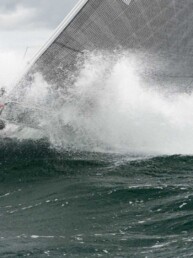
Boats & Gear , Featured , Cruising Technique
#TBT: Which Anchor to Choose?
May 30, 2024
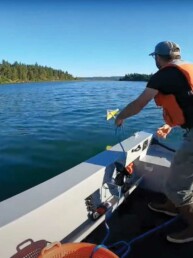
Boating Lifestyle , Featured
Editor’s Letter: Sometimes, It Is About the Destination
May 29, 2024

Rough and Rewarding: Pacific NW Offshore 2024
May 28, 2024

Norn’s Race to the Straits, Including C.O.B. Recovery
May 24, 2024

Cruising , Featured
Tender Feelings
May 23, 2024
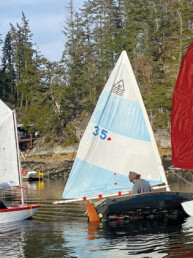

- English - United Kingdom
A Rough Guide to Mainsail Reefing
Published date: february 3 2023.
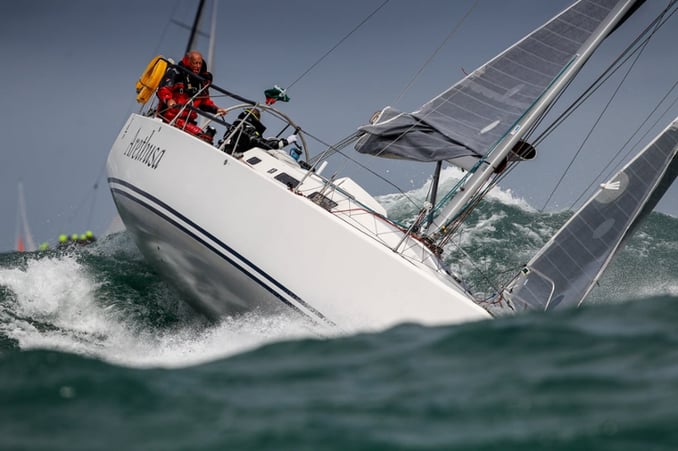
Image credit: RORC
Reducing mainsail area effectively is an essential aspect of depowering the boat as the wind strength increases. For offshore racing or cruising it is particularly important to be able to do so quickly and safely and this becomes even more critical when sailing shorthanded. Without weight on the rail, the need to reef comes earlier and the ability to deal with a situation is reduced. A mainsail reefing system should be reliable, quick to operate and produce an adequate sail shape once reefed. In this blog we discuss 4 options for taking a slab in the main.
Conventional Slab Reefing

Image credit: Calanach Finlayson
Perhaps the most common form of slab reefing is with a 2:1 reef line at the clew and a ram’s horn at the gooseneck. Reefing requires a crewmember to pull down on the luff and hook the reef cringle onto the ram’s horn. The luff is then tensioned on the halyard before cranking on the reef line. In the absence of a ram’s horn, a snap shackle can be lashed in position on a mast padeye or to the gooseneck.
Advantages:
- Only 1 line required per reef
- Minimal setup needed
- Independent control of luff tension and foot tension once reefed
Disadvantages:
- Requires a crew member venturing to the mast
Dual Line Reefing
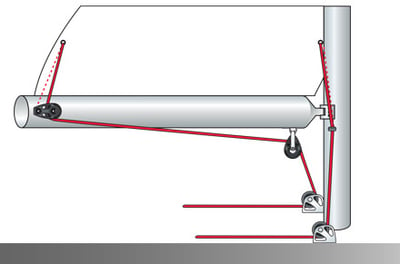
Image credit: Harken
A dual line reef system replaces the hook or shackle at the gooseneck with an additional luff Cunningham line at every reef. Reducing sail area is done by lowering the mainsail, pulling down on the reef Cunningham and locking it off in a clutch or jammer. The halyard is then tensioned followed by the reef clew line as before. This is a good option for shorthanded racing or cruising, as long as you have enough space in the cockpit for all the lines and clutches.
- Reefing can be done from the cockpit
- Independent control of luff and foot tension once reefed
- Requires two lines and clutches for every reef
Single Line Reefing
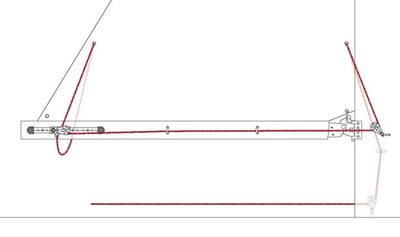
Image credit: Barton Marine
A single line system is all about ease of use. Each reef has one line which runs from the cockpit, first to the tack and then along the boom to the clew. With the main halyard lowered, winding on the reef line simultaneously pulls down the luff and the clew.
- Easy to use
- Only one line per reef
- Lots of line length to manage when taking reefs in and out
- Added friction
- No independent control over foot tension
- All the load is carried through one line
Reef Hook
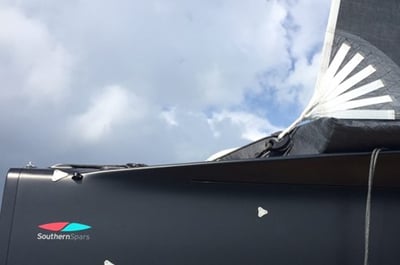
Image credit: Karver Systems
A reef hook or lock is an alternative to all the methods listed above where the reef clew line is replaced by a locking mechanism. This system is typically only used on racing boats or performance cruisers over 45ft in order to reduce the compression in the boom and the number of loaded lines on clutches. To engage the reef the mainsail is lowered and first the clew hook is engaged. Then the luff is re-tensioned using the Cunningham / main halyard depending on the exact setup and whether there is also a main halyard lock.
- Reduced boom compression
- No highly loaded reef clew line in cockpit jammer
- Additional hardware cost can be high
- Foot tension pre-determined by hook position
Conclusion
Mainsail reefing requires pre-planning to configure a good system, and practice using it. Once setup well, it can be super straightforward to reduce sail area. The 4 options outlined in this blog each offer different benefits and drawbacks depending on your boat and style of sailing. In all cases, high quality components go a long way to making the system as efficient as possible. Ensure you have low friction blocks, good clutches/jammers and look for low stretch reef line with a durable grippy cover such as polyester/Technora.
If you have any questions about reefing, please feel free to email us at [email protected] , or click the link below:
Calanach Finlayson
- There are no suggestions because the search field is empty.
We are constantly reporting on the latest innovations in the marine industry which offer weight savings whilst, at the same time, increasing safety factors. The result: lighter, faster, safer and more exciting sailing.
Recent posts, popular posts.
- Furling (55)
- Code Zero Furling (43)
- Karver (40)
- Ronstan (30)
- Electronics (29)
- Blocks and Sheaves (25)
- Sheets (25)
- Winches (25)
- Facnor (24)
- Halyards (24)
- Harken (24)
- Control Lines (23)
- Gottifredi Maffioli (23)
- Dyneema® (22)
- All Purpose Blocks (20)
- Soft Shackles (18)
- Spars and Rigging (17)
- Upffront (17)
- Jib Furlers (16)
- Manual Winches (16)
- Clutches and Organisers (13)
- Mooring and Anchoring (13)
- Spinlock (13)
- Upffront News (13)
- Andersen (12)
- Furling Lines (12)
- Instrument Systems (12)
- Electric Winches (11)
- Loop Products (11)
- Shackles and Fixings (11)
- Armare Ropes (10)
- Morfrac Systems (10)
- Sailing GPS Computers (10)
- Toolkit (10)
- Bowsprit (9)
- Halyard Locks (9)
- Spinnaker Gear (9)
- Winch Handles (9)
- Fenders (8)
- Kohlhoff Rigging (8)
- Standing Rigging (8)
- Structural Furlers (8)
- Tips and Tricks (8)
- Ubi Maior Italia (8)
- Code Zero Furling Sets (7)
- Cyclops Marine (7)
- Oleu Watersports (7)
- Rope Clutches (7)
- Sailing Shackles (7)
- Tylaska (7)
- Velocitek (7)
- Boat Anchors (6)
- Cylindrical Fenders (6)
- Furling Sets (6)
- KZ Race Furler (6)
- Navigation Lights (6)
- PROtect Tapes (6)
- Profurl (6)
- Rigging Projects (6)
- Rope Cleats (6)
- Rope Jammer (6)
- Torsion Cables (6)
- Wichard (6)
- Allen Brothers (5)
- Autopilots (5)
- Boat Compasses (5)
- Code Zero and Asymmetric Furler Accessories (5)
- Deck Organisers (5)
- Mooring Lines (5)
- Outils Ocean (5)
- Premium Ropes (5)
- Racing Halyards (5)
- Racing Sheets (5)
- Robline (5)
- Round Fenders (5)
- Runner Blocks (5)
- Sailmon (5)
- Top-Down Furler Sets (5)
- Trogear (5)
- Anchor Chains (4)
- B&G (4)
- Backstay Cables (4)
- Cam Cleats (4)
- Digital Load Cells (4)
- Electric Furlers (4)
- Fenderess (4)
- Ferrules and Rings (4)
- Headfoils (4)
- Industry News (4)
- Morfblock (4)
- Reef Hooks (4)
- Snap Shackles (4)
- Structural Furler Accessories (4)
- Backstay (3)
- Bottom-up Furler Sets (3)
- Bullet Locks (3)
- Calypso Electronics (3)
- Cousin Tresec (3)
- Electric Winch Accessories (3)
- Fairleads (3)
- Flat Fenders (3)
- Foot and Cheek Blocks (3)
- Headsail Furling (3)
- Individual parts (3)
- Instrument Displays (3)
- Internal Locks (3)
- Life Jackets (3)
- Lifelines (3)
- Lopolight (3)
- Novasail (3)
- Race Computers (3)
- Sail Hanks (3)
- Sail Hardware (3)
- Sailing instruments (3)
- Snatch Blocks (3)
- Snuffers (3)
- Tiller Extensions (3)
- Tuff Luff and Harken Sets (3)
- TuffLuff (3)
- UK Sailmakers (3)
- Wireless Modules (3)
- Autopilot Drives (2)
- Black Box Snuffers (2)
- Boat Fairleads and Organisers (2)
- Clutch units (2)
- Cutter Rig (2)
- Ewincher (2)
- Excrusion Only (2)
- External Locks (2)
- Fiddle Blocks (2)
- Fixed Tiller Extensions (2)
- Foredeck Club (2)
- Future Fibres (2)
- Grab Bags (2)
- Hall Spars (2)
- Handheld VHF Radios (2)
- Ino-rope (2)
- Lash Thimbles (2)
- Life Jacket Accessories (2)
- Main Halyard Shackles (2)
- Mainsheet Purchase systems (2)
- Mantagua (2)
- PTFE Tapes (2)
- Padeyes (2)
- Polyform fenders (2)
- Resins, Lubes and Gels (2)
- Rope Bags (2)
- Safety Lines (2)
- Sailing Dogbones (2)
- Seasure (2)
- Sheaves (2)
- Soft Hanks (2)
- Solent Rig (2)
- Southern Spars (2)
- Storm Sails (2)
- Tellescopic Tiller Extensions (2)
- Tiller Pilots (2)
- Top down sets with stay (2)
- Winch Feeders (2)
- fendress (2)
- ACR Electronics (1)
- Alphalock (1)
- Backstay Tensioners (1)
- Boom Vangs (1)
- Bow Shackles (1)
- Carbo-Link (1)
- Clevis pins (1)
- Clutch Parts (1)
- Clutch Repair Kits (1)
- Continuous Furling Lines (1)
- D-Shackles (1)
- DCSolar (1)
- DrSails (1)
- Dyneema® Covers (1)
- Electronics Accessories (1)
- Fendertex (1)
- Fids and Spikes (1)
- Flipper (1)
- Fourthcape (1)
- Halyard Blocks (1)
- Horn Cleats (1)
- Jackline (1)
- Jib Furler Accessories (1)
- Lead blocks (1)
- Life Jacket Spares (1)
- Low Friction Rings (1)
- Mainsail Furling (1)
- Manual Genoa Furlers (1)
- Navisafe (1)
- Polyform (1)
- Polyform US (1)
- Prism 2 (1)
- Reckmann (1)
- Rigging Tools (1)
- Rigid Boom Vangs (1)
- Rope Covers (1)
- Rope Purchases (1)
- Sailing Dinghy Tape Kits (1)
- Sailserver (1)
- Schaefer Marine (1)
- Single Furling Lines (1)
- Smartlink (1)
- Smarttune (1)
- Solar Power (1)
- Staysail (1)
- Strops and Loops (1)
- Tikal Tef-Gel (1)
- Top-Down Adapters (1)
- Torsion Ropes (1)
- Vakaros (1)
- Winch Service Accessories (1)
- Wired Navigation Lights (1)
- fender covers (1)
- Customer Support
Payment Methods
- Testimonials
- News & Blog
- Download Centre
- Image Credits
- Terms & Conditions
- Privacy Policy
- Interest Based Ads
- +49 431 2202140
- : [email protected]

Yachting Monthly
- Digital edition

Essential reefing tips for cruisers
- Chris Beeson
- December 1, 2015
Reefing: how, when and why do we do it? The answers may not be as straightforward as you think, says James Jermain

Reefing need not be onerous and doing it well makes an amazing difference to the way your boat handles strong winds Credit: Graham Snook/YM

James jermain, boat test guru and former editor of YM, has sailed hundreds of yachts all over the world
Why do we reef? Simple. We reef when conditions are such that to do otherwise would risk blowing out the sails, bringing down the mast – or driving the boat under.
But stop there and you’ll have only half-answered the question. You will have missed out the most important factor – the crew. You may well also be guilty of not understanding your boat and the way she behaves. Most boats, particularly modern boats, share with their crews a liking for sailing upright, under good control and comfortably.

With too much sail up, the mainsheet trimmer will be worn out working the traveller – and one lurch away from a fall across the cockpit
In short, thrashing to windward at 30 degrees, tiller under chin, main flogging and spray sweeping the cockpit, may be exhilarating and macho for a short time, but your crew will quickly lose the will to sail with you ever again. You will also be shortening the life of your gear and, you may be surprised to see, the nicely snugged-down boat that was somewhere over your leeward quarter is now stretching away on your weather bow.
Newcomers to sailing often take a while to shake off the notion that the stronger the wind and the bigger the sails, the faster you can get the boat to go. But that’s definitley not the case.
Take a moment to consider the shape of your boat underwater when she’s sailing on a more or less even keel – she has nicely flowing curves, well balanced on both sides. The rig is standing over the boat with the centre of effort driving forward more or less along the centreline and over the bow.

Upright, water flows evenly around the hull. When heeled the water flows very differently, encouraging her to round up
Now picture the boat heeled to 30°. On one side the waterline is a sharp curve, the other almost straight. The hull is trying to hook up to windward and to compensate you have to pull the rudder hard over across the water flow, where it acts more as a brake than a steering foil. The keel is no longer as deep, has less grip on the water and its centre of resistance (drag) is to windward of the centreline.
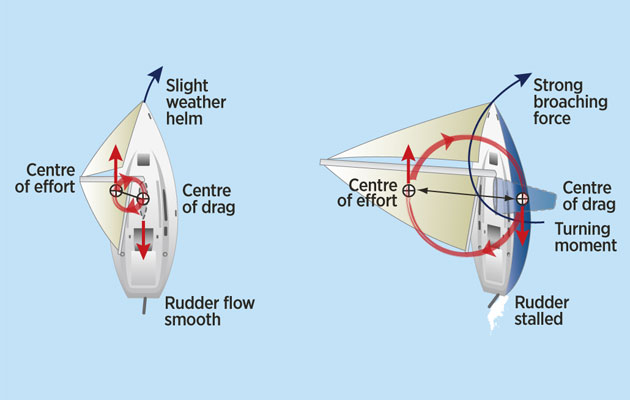
Heeling increases weather helm due to different waterline profiles (see above) and the turning moment that results from the separation of the Centre of Effort and Centre of Drag. Reefing reduces heel, bringing them closer, so reducing weather helm and improving waterline profile
Meanwhile the rig is well over to the lee side. The centre of effort is somewhere over the sea to leeward and is also dragging the boat round into the wind. You are having to stall the main and lose drive just to keep the boat under control. You are going slowly, sailing further in a series of curves, and leeway is carrying you off your course.
And we haven’t even started to consider the lot of the poor crew hanging on by their fingertips, wet, tired and considerably below mental and physical par.
So the answer to ‘Why do we reef?’ on a cruising boat is to:
- Preserve and protect the crew
- Preserve and protect the boat and equipment
- Sail faster and more efficiently
When to reef?

Few people relish crew work in lively conditions. Reef early and there’ll be no complaints
An old adage states that: ‘The time to reef is when you first think of it.’ And it’s true. In a cruising context, you will seldom regret reefing early and you will almost always regret reefing late. In practice choosing the right moment to reduce sail is a matter of knowing and understanding your boat, your crew and the conditions – in other words it’s ‘experience’. However, here are some reasonably reliable guidelines for a typical modern, medium-sized cruising yacht:
- Wind speed Most boats are designed to require the first reef in around 18 knots apparent wind when sailing to windward. Some lighter, more coastal-orientated boats may struggle in 15 knots while heavier offshore designs will still be happy at 20 knots or more.

Heavier displacement boats like this Hallberg-Rassy can wear their canvas longer than lighter boats, but she still seems heavily pressed
- Sea state The sea state can have an important bearing. Short, steep seas can stop a boat in its tracks and one that is over-pressed will drive its bows into the face of a wave. Reducing sail, particularly the headsail will allow the boat to ride over the waves comfortably and keep up speed. However, there is another side to this – by reducing sail too much you may not leave enough power to make way against big seas. Knowing your boat will allow you to balance these factors.
- Crew ability As the wind builds so do the loads on the control lines – sheets, halyards and reefing pennants. A thoughtful skipper will know the strength of his crew and won’t hang on to sail beyond their ability. This is especially true if it’s necessary to go up to the mast or foredeck as part of the reefing process. An over-pressed boat is a much less safe working platform. The thoughtful skipper will also bear in mind the possibility that things might go wrong and need time to resolve – do you have this time and can your crew work in the current conditions?
How to make reefing easier
One reason people delay reefing is that it can be hard and potentially dangerous work. Make it quicker and easier and it will be done sooner.

Marking the genoa foot creates ‘gears’ that can easily be reefed to
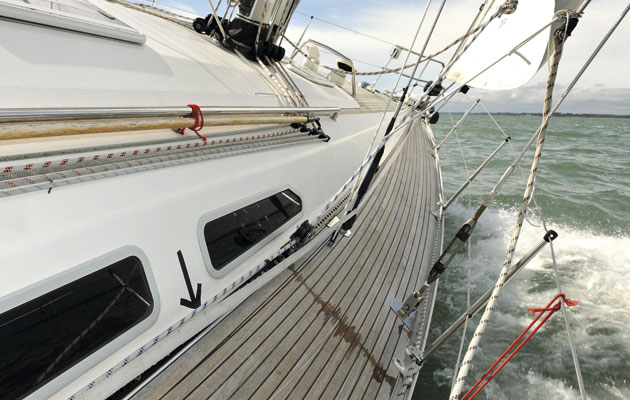
Mark the sheet car position for the same reason
Mark where everything needs to be for each reef – main halyard, kicker, reefing lines, sheet cars, genoa foot, backstay
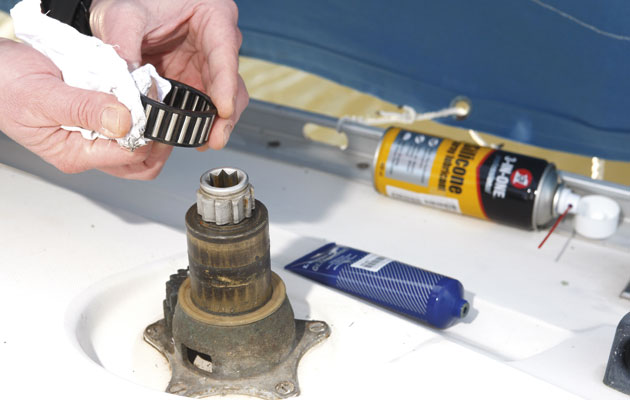
Doing all you can to make reefing easier and quicker, which includes servicing winches and furlers, will be popular with the crew
Service, maintain and lubricate (as appropriate) all reefing equipment – roller furling gear, winches, jammers, sheet cars, batten cars, main traveler

Car tweakers help you get the right sheeting angle for the reefed genoa without going forward

Fitting full battens and ball sides means the sail sets better and is easier to haul down to reef
Consider equipment upgrades: blocks instead of cringles, stack pack and lazyjacks, full length battens (that reduce flogging and noise and set flatter), better luff cars/slides, more powerful roller furling
The best way to trim reefed sails
Just because there is plenty of wind and the boat is making good speed doesn’t mean sail trim can be ignored. On the contrary, the boat will be operating close to its limits so every scrap of sail efficiency will help. Poorly set sails will add to leeway, which is probably already quite significant. They will also reduce the drive available to cope with big waves while increasing the yacht’s heeling and crew’s discomfort.

When the headsail is half-furled, the slot between the sails is much bigger, so you can ease off the traveller or mainsheet
The big thing to remember is that, with less genoa overlap (assuming it has been partly rolled), and a more open slot, the mainsail can be eased out significantly. Drop the traveller down as far as you can without stalling the luff and even be prepared to accept a bit of lifting here. This will keep the boat more upright, reduce leeway and increase forward drive.
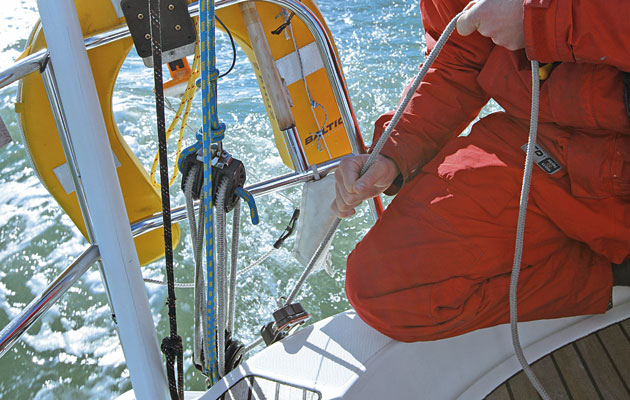
Increase backstay tension when close hauled in strong winds to stop the headstay from sagging
Keep the sail flat. Make sure the leech cringle is hard down to the boom to stretch out the foot, harden up the halyard and increase backstay tension.

With the car forward, the sheeting angle of a well-set headsail bisects the clew, balancing the load along the leech and foot of the sail
The important thing here is the sheet lead. As the sail is rolled the lead needs to be moved forward to maintain the angle through the sheet, roughly bisecting the clew. The aim is to balance the load along the foot and leech, so that there is not too much twist in the sail or too much fullness. Make sure you have tell-tales that are still visible when the sail is well rolled so you can position the sheet car accurately. There is not much you can do with the halyard once the sail has been rolled, but before you start, do check that the luff is well tensioned to flatten the sail and remove luff wrinkles. This will make the sail roll more easily and set flatter. Backstay tension will also improve set, by reducing forestay sag.
How to reef when sailing off the wind

It is all too easy to ignore a rising wind in the thrill of a high-speed downwind sleigh-ride
So far we have looked at reefing with the boat hard on the wind, round to a beam reach. From this point on you need to consider some extra factors.
For one thing, once you are running off downwind, apparent wind drops away, the boat comes upright and all seems to be well. Always be aware of the true wind speed. It is all too easy to ignore a rising wind in the thrill of a high-speed downwind sleigh-ride. Never lose sight of what conditions might be like if you suddenly had to turn into the wind.
I’m not suggesting you should run with a sail plan reduced to cope with an upwind beat (although on a catamaran it’s not bad practice), but remember it’s not always easy to reef downwind and you may have to round up at least to a beam reach before you can manage it.

The problem with reefing downwind is that you can’t depower the mainsail. Luff slides can jam and the main will drape over the spreaders
The problem with reefing downwind is that you cannot depower the main. As soon as you ease the halyard, the sail will tend to fall across the shrouds and spreaders, particularly if they are swept well aft. The pressure in the sail will also be forcing it forward onto the mast and the slides/cars will tend to jam in the track. Dragging a sail down over the spreaders and shrouds, even if it is possible, will almost certainly cause damage.
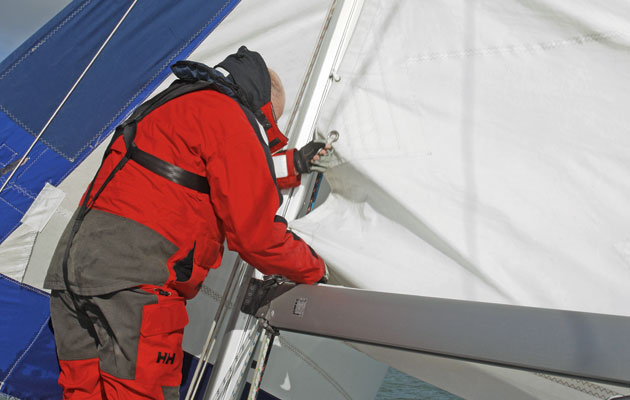
Reef the mainsail early and deep. Use the genoa to fine-tune the sail area
The genoa is much easier to reef downwind. The loads are light and the reefing line will be easy to pull in. The genoa also tends to pull the boat along, rather than push it, so it generates less broaching movement.
Everything, therefore points towards reefing the main early and deeply and then fine-tuning the total sail area with the genoa.
But, you may say, on a deep run, the genoa won’t stand well. The answer is to pole it out or sail high enough to keep it filled and stable. Tacking downwind not only keeps the genoa filled and stable, but it can also be faster, or as least as quick as, a dead run. This is particularly true of lightweights and catamarans, but less so for heavy displacement long-keelers.
Reefing theory in practice

Too much heel: we’re powering along but it’s hard work and she’s going sideways fast
As all sailors know, the theory is only half the story. Things can be a lot less predictable out on the water. We went sailing in the Solent in perfect wind conditions for reefing research. The breeze built from nine to 24 knots apparent to windward (three to 18 knots true or Force 2 to 5), giving realistic conditions for taking in one and then two reefs. More to the point, it showed exactly why early reefing really works.
Our boat was a Jeanneau Sun Fast 37 on loan from the Hamble School of Yachting: a fast cruiser-racer with a roller furling headsail and a slab reefing mainsail.
As the apparent wind rose above 18 knots, we suffered the first of a series of broaches. While maximum boat speed remained reasonably high (just over six knots), the average course to windward fell from around 33 degrees to closer to 40 degrees as leeway increased, and continually rounding up lowered our average speed.
The mainsheet trimmer was having to work hard dropping the traveller and easing the main to keep the boat on her feet and all control lines were fully loaded.

Much better! Less power, but less hard work, more boatspeed, a lot less leeway and a happier, more comfortable crew
As soon as we eased off the main in preparation for reefing, the boat came upright and the cockpit was a nicer place to work. The first reef dropped in quickly, and six rolls of the genoa brought it down to working jib size. We sheeted in, trimmed the sails and immediately the boat gained half a knot top speed. More importantly, she was able to maintain that speed and hold a wind angle of 33 degrees without rounding up. She still had the power to drive through a short chop, the mainsheet hand could relax and life in the cockpit and below was much more civilised. As the wind approached 24 knots, the same procedure was repeated, with similar results – easier motion, increased speed, more comfort, less leeway, less work.
Reefing on cats, cutters, ketches and yawls

This Mahé 36 needs less mainsail to reduce power and more jib to provide some lift at the bow
The problem with cats is the stronger the wind, the faster they go, until…
The signs that a cat is over-pressed can be subtle and take some experience to sense. So reefing a cat is largely a numbers game – first reef at x knots in flat seas, x-y knots in heavy seas, x-z in breaking seas. Sea state is almost more important than wind strength. The big danger is burying the lee bow and pitchpoling. Reduce the often large and big-roached main area ahead of the smaller jib and you will keep the downward pressure to a minimu
Cutters and ‘slutters’

If the wind picks up, just furl the yankee and the staysail will keep her pointing
Twin headsails allow great flexibility in reefing. Traditional cutters with a high-cut yankee jib and small (self-tacking) staysail, can be reefed by dropping one or other sail, the remaining one being left in conditions up to gale force. Modern ‘slutters’ with a big, genoa-sized headsail and a smaller staysail are usually sailed single-headed, with the genoa often full cut and used only in light airs or off the wind. In wind of 15 knots or more, the headsail is furled and the small, tough staysail can again cope with winds up to gale force.
Ketches and Yawls

Ketch advantage: in moderate to strong winds you don’t need the mainsail at all
Although out of favour for good reason, twin-masted boats are often perfect for heavy weather sailing, being able to set or dowse a number of sails in many combinations without having to reef or roll any of them. The boat can always be well balanced and the sails set most efficiently.
Enjoyed reading this?
A subscription to Yachting Monthly magazine costs around 40% less than the cover price .
Print and digital editions are available through Magazines Direct – where you can also find the latest deals .
YM is packed with information to help you get the most from your time on the water.
- Take your seamanship to the next level with tips, advice and skills from our experts
- Impartial in-depth reviews of the latest yachts and equipment
- Cruising guides to help you reach those dream destinations
Follow us on Facebook , Twitter and Instagram.
Yachting World
- Digital Edition

How to reef short-handed and how to know when the time is right to reduce sail
- February 17, 2017
Reefing offers numerous benefits to a hard-pressed yacht and its crew – so set your boat up to make it as easy as possible.

The decision to reef is as much about boat handling as it is about wind strength. So try to take a holistic view of how the whole boat feels and don’t let the numbers on the wind instruments dictate your behaviour.
When sailing upwind, consider the boat’s angle of heel, the sea state and the amount of helm being used to keep the boat on course. Too much of any of these factors is reason enough to reef. Also, bear in mind that reefing early on a long upwind passage often pays and if your mainsail is getting a little bit older, taking the first slab out of the bottom can give a flatter shape.
When sailing downwind or reaching short-handed, be proactive; a manageable boat is essential and reefing on these points of sail will mostly help with boat handling. Listen to the autopilot motor when down below or watch the movement of the helm. If the corrections are frequent and/or large, then it is time to reef.
Under spinnaker in moderate seas it is often a full mainsail that causes handling issues rather than the kite. Sailors tend to drop the spinnaker first then still end up reefing when the boat handling doesn’t change. If using a masthead spinnaker, be sure the top of your mast is supported well enough without the full main. If in doubt, ask a rigger.
Finally consider your overall objectives for the next 24 hours. If you need to make repairs, cook, clean or charge the batteries reefing can make everything easier. When there are only two crew members on board, it is important not to lose sight of the bigger picture – even if the boat can take the extra sail, dropping the pace for a while might be of benefit in the long run.
Reefing tips
There is no need to make huge course alterations in order to reef your mainsail. When sailing downwind, head up just enough to lift the back of the main clear from the spreaders. Drop your traveller to its full extent, release the kicker and ease the mainsheet a little. Another tip for reducing the amount you need to alter course is to over-trim your headsail to funnel wind into the back of the main.
Get the autopilot to drive, even if you are both on deck, to speed up the process. However, be aware that suddenly releasing pressure from the mainsail may cause the pilot to veer off course, so switch to compass mode and increase the response rate if necessary.
Before easing the halyard, make sure the reefing lines are fastened far enough back on the boom to provide tension in the new main foot as well as in the leech. If necessary, use a secondary reefing line as a makeshift outhaul.
If you prefer not to leave the cockpit for reefing, a two-line system is fairly simple to rig up. Keep a downhaul line attached to each of the cringles at the front end of the sail and run each one through a block at the foot of the mast and then aft through jammers on the coachroof.
With the wind aft or on the beam get the main clear of the spreaders by over-sheeting the jib to create a backdraft.
Swap your rams’ horns for snap shackles on Dyneema strops to ensure your reefing cringles never stray from the boom.
Whip marks into your main halyard showing how far to drop when hooking on each reef. Luminous or white twine shows up at night.
Use elastic sail ties to tidy the remaining slabs of sail. If the slabs fill with water, the weight will stretch the elastic, draining the sail.

Marking the halyard with whipping twine will take the guesswork out of reducing sail.

Use a downhaul line attached to the rams’ horns or to a strop to control the new tack of the main.

Locking off the first reef pendant on this simple slab reefing arrangement.

- Search forums
- Yachting Monthly's Scuttlebutt
Reefing Lines to cockpit
- Thread starter alundavies
- Start date 29 Nov 2006
- 29 Nov 2006
After reading a lot about various reefing systems, I'm going to install a two line reefing system on my boat and wish to bring all the lines back to the cockpit. I need advice on how best to strengthen the deckat the base of the mast where the lines will pass through blocks. The deck is made of about 40mm plywood. I have geard that I will need to link the blocks to the hull with steel wire? I would be grateful for any comments.
Well-known member
Welcome Alderman. You dont say what size boat, as this has a large bearing on the apparent loads. My deck stepped Jeanneau has all the blocks attached to the mast stap casting, which seems to be adequate on 35ft masthead with 3 reefs all single line. I havent heard of wire strops to the cabin sole, but 40mm plywood sounds strong. Try installing a load spreader plate on the underside of the cabin roof, should be enough.

If you have rope locks in the boom for the reefinglines , like I do, then all the stress stays in the boom and you don't need extra strengthening for the deck.
I have two spare StSt plates like the ones shown in your picture [the bottom ones] I always wondered what they were for, they came with a job lot of boating stuff, now I know I can put them up for sale
"all the stress stays in the boom" ummm.. 1. It can't do if you are pulling the reefs in - only when you release the pull in the cockpit. 2. How do you let them out ? Ken
Other threads that may be of interest
- stone beach
- Practical Boat Owner's Reader to Reader
- 11 May 2024
- Motor Boat Forum
- 13 May 2024
- East Coast Forum
Members online
- Andrew_Fitton
- snowbird30ds
- chriswesterman
- Another One
- jane444blue
- Charlie Boy
- Fr J Hackett
- agroundagain
Share this page
Bavaria Yacht Info

- Bavaria Yacht Info »
- Member Forums »
- Bavaria Yacht Help! »
- What rope for in mast endless reefing line?
Author Topic: What rope for in mast endless reefing line? (Read 2136 times)
- Second Mate
- Karma: +0/-0
- Boat Model: Bavaria 44 AC
- Boat Year: 2003
- Karma: +2/-0
- Boat Model: Bavaria 44
Re: What rope for in mast endless reefing line?
- Karma: +6/-0
- Boat Model: Bavaria 40
- Boat Year: 2001
- Able Seaman
- Karma: +3/-0
In any case I think that the solution is to change the sheaves of the winch at the mast
- Karma: +9/-4
- 2014 Cruiser 37
- Boat Model: Cruiser 37
- Boat Year: 2014
Thanks, on my furler I also saw that B12 and B19 are also worn out. I read the instructions, Selden recommends to take the mast off and disassemble the unit while the mast is in a horizontal position. I heard from someone in the marina that he took out the whole furler unit on a standing mast - he somehow fixed the furler tube in the mast that it did not fall down.
- Boat Model: 46 Cruiser
- Boat Year: 2005
- SMF 2.0.19 | SMF © 2017 , Simple Machines
- Bahasa Indonesia
- Slovenščina
- Science & Tech
- Russian Kitchen
Cruising the Moskva River: A short guide to boat trips in Russia’s capital

There’s hardly a better way to absorb Moscow’s atmosphere than on a ship sailing up and down the Moskva River. While complicated ticketing, loud music and chilling winds might dampen the anticipated fun, this checklist will help you to enjoy the scenic views and not fall into common tourist traps.
How to find the right boat?
There are plenty of boats and selecting the right one might be challenging. The size of the boat should be your main criteria.
Plenty of small boats cruise the Moskva River, and the most vivid one is this yellow Lay’s-branded boat. Everyone who has ever visited Moscow probably has seen it.

This option might leave a passenger disembarking partially deaf as the merciless Russian pop music blasts onboard. A free spirit, however, will find partying on such a vessel to be an unforgettable and authentic experience that’s almost a metaphor for life in modern Russia: too loud, and sometimes too welcoming. Tickets start at $13 (800 rubles) per person.
Bigger boats offer smoother sailing and tend to attract foreign visitors because of their distinct Soviet aura. Indeed, many of the older vessels must have seen better days. They are still afloat, however, and getting aboard is a unique ‘cultural’ experience. Sometimes the crew might offer lunch or dinner to passengers, but this option must be purchased with the ticket. Here is one such option offering dinner for $24 (1,490 rubles).

If you want to travel in style, consider Flotilla Radisson. These large, modern vessels are quite posh, with a cozy restaurant and an attentive crew at your service. Even though the selection of wines and food is modest, these vessels are still much better than other boats.

Surprisingly, the luxurious boats are priced rather modestly, and a single ticket goes for $17-$32 (1,100-2,000 rubles); also expect a reasonable restaurant bill on top.
How to buy tickets?
Women holding photos of ships promise huge discounts to “the young and beautiful,” and give personal invitations for river tours. They sound and look nice, but there’s a small catch: their ticket prices are usually more than those purchased online.
“We bought tickets from street hawkers for 900 rubles each, only to later discover that the other passengers bought their tickets twice as cheap!” wrote (in Russian) a disappointed Rostislav on a travel company website.
Nevertheless, buying from street hawkers has one considerable advantage: they personally escort you to the vessel so that you don’t waste time looking for the boat on your own.

Prices start at $13 (800 rubles) for one ride, and for an additional $6.5 (400 rubles) you can purchase an unlimited number of tours on the same boat on any given day.
Flotilla Radisson has official ticket offices at Gorky Park and Hotel Ukraine, but they’re often sold out.
Buying online is an option that might save some cash. Websites such as this offer considerable discounts for tickets sold online. On a busy Friday night an online purchase might be the only chance to get a ticket on a Flotilla Radisson boat.
This website (in Russian) offers multiple options for short river cruises in and around the city center, including offbeat options such as ‘disco cruises’ and ‘children cruises.’ This other website sells tickets online, but doesn’t have an English version. The interface is intuitive, however.
Buying tickets online has its bad points, however. The most common is confusing which pier you should go to and missing your river tour.

“I once bought tickets online to save with the discount that the website offered,” said Igor Shvarkin from Moscow. “The pier was initially marked as ‘Park Kultury,’ but when I arrived it wasn’t easy to find my boat because there were too many there. My guests had to walk a considerable distance before I finally found the vessel that accepted my tickets purchased online,” said the man.
There are two main boarding piers in the city center: Hotel Ukraine and Park Kultury . Always take note of your particular berth when buying tickets online.
Where to sit onboard?
Even on a warm day, the headwind might be chilly for passengers on deck. Make sure you have warm clothes, or that the crew has blankets ready upon request.
The glass-encased hold makes the tour much more comfortable, but not at the expense of having an enjoyable experience.

Getting off the boat requires preparation as well. Ideally, you should be able to disembark on any pier along the way. In reality, passengers never know where the boat’s captain will make the next stop. Street hawkers often tell passengers in advance where they’ll be able to disembark. If you buy tickets online then you’ll have to research it yourself.
There’s a chance that the captain won’t make any stops at all and will take you back to where the tour began, which is the case with Flotilla Radisson. The safest option is to automatically expect that you’ll return to the pier where you started.
If using any of Russia Beyond's content, partly or in full, always provide an active hyperlink to the original material.
to our newsletter!
Get the week's best stories straight to your inbox
- What to do in Moscow City, if you’re not mega-rich
- Moscow after dusk: 10 places to drink, dance, and groove
- 5 things you must do in Moscow in 2018 between football matches (or without them)
- Sandwiched between Moscow and St. Petersburg: How to spend a perfect weekend in Tver
- 24 or 48 hours in Moscow: Where to go and what to do in 2019
This website uses cookies. Click here to find out more.
Flotilla Radisson Royal

- See all photos

Most Recent: Reviews ordered by most recent publish date in descending order.
Detailed Reviews: Reviews ordered by recency and descriptiveness of user-identified themes such as wait time, length of visit, general tips, and location information.
Flotilla Radisson Royal - All You Need to Know BEFORE You Go (2024)
More From Forbes
Cantieri di pisa introduces new line of voyager yachts.
- Share to Facebook
- Share to Twitter
- Share to Linkedin
Cantieri di Pisa may be a historic Italian shipbuilding brand that was founded in 1945. But there’s nothing old-fashioned about the new breed of voyager yachts they just introduced.
The yard’s chief designer Antonio Luxardo created the exterior lines for the entire line. Optima Design is responsible for the engineering. The interior design of the new 157-foot-long Polaris 48 is by Parisotto + Formenton that will be the first of Cantieri di Pisa’s new range that will be built of steel and aluminum with an Eco High Power Hull (EHPH) displacement hull for long-range cruising and low fuel consumption. Plans are also in the works to build a Polaris 38- and Super Polaris 60-meter-long yachts as well.
The Polaris 48 has amazing deck space
“The new line features different types of boats and materials compared to the brand’s past production, but with immediately recognizable lines that tap into its traditional values,” says Luxardo. “The Polaris 48 is classified as a voyager because it has the range of an explorer but also offers incredibly versatile exteriors and highly sophisticated interiors. The main characteristic is the livability of the upper and main decks, which feature two large interconnecting water’s edge terraces that can be used in different ways and can accommodate everything needed to explore the surrounding area and play water sports.”
the upper deck aboard the Polaris 40
Google Chrome Deadline 72 Hours To Update Or Delete Your Browser
The fed quietly ‘admits’ gold is replacing the dollar as collapse ‘fear’ predicted to trigger a $15.7 trillion etf bitcoin price gold flip, apple loop iphone 16 pro details ios 18 s ai plans iphone 14 pro special offer.
In fact, the main deck is dedicated to two large cabins –a master suite and a VIP stateroom –in addition to roughly 2,150 square feet of common living space, a 538 square foot interior lounge and 1,600 square feet of ultrs-luxe outdoor
In addition to the two cabins on the main deck, there are four more guest cabins on the lower deck.
The stylish main salon of the Polaris 48
The interior design by Parisotto + Formenton, is notable because the founders—Aldo Parisotto and Massimo Formenton—are active in various fields, from museum and commercial projects to indoor and outdoor design around the world.
For the first yacht in this line, the interiors are light and warm based on shades of brown and white. As a tribute to the firm’s tradition, Parisotto and Formenton chose materials evoking the old Akhir line, including pickled teak, carbon fiber, bronze, glass and brass.
The only question now is: when will the first one be launched? My guess is it won’t be long. Stay tuned.

- Editorial Standards
- Reprints & Permissions
Join The Conversation
One Community. Many Voices. Create a free account to share your thoughts.
Forbes Community Guidelines
Our community is about connecting people through open and thoughtful conversations. We want our readers to share their views and exchange ideas and facts in a safe space.
In order to do so, please follow the posting rules in our site's Terms of Service. We've summarized some of those key rules below. Simply put, keep it civil.
Your post will be rejected if we notice that it seems to contain:
- False or intentionally out-of-context or misleading information
- Insults, profanity, incoherent, obscene or inflammatory language or threats of any kind
- Attacks on the identity of other commenters or the article's author
- Content that otherwise violates our site's terms.
User accounts will be blocked if we notice or believe that users are engaged in:
- Continuous attempts to re-post comments that have been previously moderated/rejected
- Racist, sexist, homophobic or other discriminatory comments
- Attempts or tactics that put the site security at risk
- Actions that otherwise violate our site's terms.
So, how can you be a power user?
- Stay on topic and share your insights
- Feel free to be clear and thoughtful to get your point across
- ‘Like’ or ‘Dislike’ to show your point of view.
- Protect your community.
- Use the report tool to alert us when someone breaks the rules.
Thanks for reading our community guidelines. Please read the full list of posting rules found in our site's Terms of Service.
Advertisement
Supported by
Optimistic About the War in Ukraine, Putin Unleashes a Purge at Home
Despite years of criticism, President Vladimir V. Putin has only now changed his defense minister and allowed high-level corruption arrests.
- Share full article

By Paul Sonne and Anatoly Kurmanaev
Reporting from Berlin
Periodic outcries over incompetence and corruption at the top of the Russian military have dogged President Vladimir V. Putin’s war effort since the start of his invasion of Ukraine in early 2022.
When his forces faltered around the Ukrainian capital, Kyiv, the need for change was laid bare. When they were routed months later outside the city of Kharkiv, expectations of a shake-up grew. And after the mercenary leader Yevgeny V. Prigozhin marched his men toward Moscow, complaining of deep rot and ineptitude at the top of the Russian force, Mr. Putin seemed obliged to respond.
But, at each turn, the Russian president avoided any major public moves that could have been seen as validating the criticism, keeping his defense minister and top general in place through the firestorm while shuffling battlefield commanders and making other moves lower on the chain.
Now, with the battlefield crises seemingly behind him and Mr. Prigozhin dead, the Russian leader has decided to act, changing defense ministers for the first time in more than a decade and allowing a number of corruption arrests among top ministry officials.
The moves have ushered in the biggest overhaul at the Russian Defense Ministry since the invasion began and have confirmed Mr. Putin’s preference for avoiding big, responsive changes in the heat of a crisis and instead acting at a less conspicuous time of his own choosing.
“We have to understand that Putin is a person who is stubborn and not very flexible,” said Abbas Gallyamov, a former Putin speechwriter who now lives outside Russia. “He believes that reacting too quickly and rapidly to a changing situation is a sign of weakness.”
The timing of Mr. Putin’s recent moves is most likely a sign that he has greater confidence about his battlefield prospects in Ukraine and his hold on political power as he begins his fifth term as president, experts say.
Russian forces are making gains in Ukraine , taking territory around Kharkiv and in the Donbas region, as Ukraine struggles with aid delays from the United States and strained reserves of ammunition and personnel . Top officials in the Kremlin are feeling optimistic.
“They likely judge the situation within the force as stable enough to punish some in the military leadership for its prior failures,” said Michael Kofman, an expert on the Russian military and a senior fellow at the Carnegie Endowment for International Peace.
Demand for change at the top of the Russian military has been pent up since the invasion’s earliest days, when stories circulated about Russian soldiers going to war without proper food and equipment and losing their lives while answering to feckless military leaders.
The anger crested with an aborted uprising led last year by Mr. Prigozhin , who died in a subsequent plane crash that U.S. officials have said was most likely a state-sanctioned assassination .
Mr. Prigozhin , a caterer turned warlord who grew rich on state contracts, was an unlikely messenger. But he put high-level corruption on the minds of Russia’s rank and file and the public more broadly, releasing profanity-laced tirades against Sergei K. Shoigu, then the defense minister, and Russia’s top uniformed officer, Gen. Valery V. Gerasimov. At one point, Mr. Prigozhin filmed himself in front of a pile of dead Russian fighters and denounced top officials for “rolling in fat” in their wood-paneled offices.
His subsequent failed mutiny showed that the problems festering in the Defense Ministry under Mr. Shoigu for over a decade had boiled over and that the populace craved renewal, said a person close to the ministry who spoke on the condition of anonymity in order to discuss sensitive topics.
The Russian leader now appears to be moving against the very officials that Mr. Prigozhin had been attacking.
The first harbinger of change arose last month with the arrest of Timur Ivanov , a protégé of Mr. Shoigu and the deputy defense minister in charge of military construction projects whom the Russian authorities have accused of taking a large bribe. He has denied wrongdoing. Mr. Ivanov previously attracted the attention of Aleksei A. Navalny’s Anti-Corruption Foundation for his and his wife’s conspicuously lavish lifestyle, including yacht rentals on the French Riviera.
Then, this month, days after Mr. Putin began his new term as president, the Kremlin announced that he had replaced Mr. Shoigu and chosen Andrei R. Belousov, one of his longtime economic advisers, as the new defense minister. Mr. Shoigu was moved to run the Russian Security Council, where he would still have access to the president but would have little direct control over money.
Mr. Belousov has no military experience . But he boasts a relatively clean image and a long government career untainted by large corruption scandals.
“If you want to win a war, corruption at a larger scale impacting the results on the battlefield is, in theory at least, not something you want,” said Maria Engqvist, the deputy head of Russia and Eurasia studies at the Swedish Defense Research Agency.
Still, Ms. Engqvist called high-level corruption in Russia “a feature, not a bug.”
“Corruption is a tool to gain influence, but it can also be used against you at any given time, depending on whether you say the wrong thing at the wrong time or make the wrong decision at the wrong time,” she said. “So you can be ousted with a reasonable explanation that the public can accept.”
Ms. Engqvist said the changes also raised questions about how long General Gerasimov would stay in his position as chief of the general staff and top battlefield commander in Ukraine.
The arrests at the Defense Ministry have gathered pace this month, with four more top generals and defense officials detained on corruption charges. Dmitri S. Peskov, the Kremlin spokesman, denied on Thursday that the arrests represented a “campaign.”
The corruption charges against top Defense Ministry officials have come alongside promises of greater financial and social benefits for the rank-and-file soldiers, an apparent attempt to improve morale and mollify populist critics.
Mr. Belousov used his first remarks after his nomination as defense minister to describe his plans to cut bureaucracy and improve access to health care and other social services for veterans of the war. And on Thursday, the speaker of Russia’s lower house of Parliament, Vyacheslav V. Volodin, and Finance Minister Anton G. Siluanov expressed support for exempting fighters in Ukraine from proposed income-tax increases.
The high-level arrests are unlikely to root out vast corruption in the Russian military establishment, but they could make top officials think twice before stealing at a particularly large scale, at least for a period, said Dara Massicot, a senior fellow at the Carnegie Endowment for International Peace.
“It will introduce a chill into the system and make everyone pause as they try to figure out the new code of accepted behavior,” Ms. Massicot said.
Beyond sending an anticorruption message, at least one of the arrests seemed to be aimed at settling a political score.
Maj. Gen. Ivan Popov, a top Russian commander who led forces holding off Ukraine’s counteroffensive, chided the Russian military leadership in a widely seen recording last year after he was removed from his post. He was apprehended on Tuesday on fraud charges, according to the state news agency TASS. He denied wrongdoing, his lawyer said.
“The bottom line is that the war exposed a lot of different problems — corruption, incompetence and openness to public expressions of insubordination — that the leadership feels a need to address,” said Samuel Charap, a senior political scientist at the RAND Corporation. “Now is a good time to do this, precisely because there isn’t a short-term acute risk on the battlefield.”
Paul Sonne is an international correspondent, focusing on Russia and the varied impacts of President Vladimir V. Putin’s domestic and foreign policies, with a focus on the war against Ukraine. More about Paul Sonne
Anatoly Kurmanaev covers Russia and its transformation following the invasion of Ukraine. More about Anatoly Kurmanaev
Our Coverage of the War in Ukraine
News and Analysis
The decision by the Biden administration to allow Ukraine to strike inside Russia with American-made weapons fulfills a long-held wish by officials in Kyiv that they claimed was essential to level the playing field.
Secretary of State Antony Blinken suggested that Ukraine’s use of U.S.-supplied arms could expand beyond the current limitation to strikes in the Kharkiv area.
Top Ukrainian military officials have warned that Russia is building up troops near northeastern Ukraine , raising fears that a new offensive push could be imminent.
Zelensky Interview: In an interview with The New York Times, President Volodymyr Zelensky of Ukraine challenged the West over its reluctance to take bolder action.
Fleeing a War Zone: A 98-year-old Ukrainian grandmother stumbled past corpses and bomb craters to escape Russia’s attacks.
Russia’s RT Network : RT, which the U.S. State Department describes as a key player in the Kremlin’s propaganda apparatus, has been blocked in Europe since the war started. Its content is still spreading .
How We Verify Our Reporting
Our team of visual journalists analyzes satellite images, photographs , videos and radio transmissions to independently confirm troop movements and other details.
We monitor and authenticate reports on social media, corroborating these with eyewitness accounts and interviews. Read more about our reporting efforts .

COMMENTS
Imagine a yacht with a really high reef point, say for a third reef, that is located 20 feet up the luff. The reef line will need to travel from the cockpit to the mast, up the mast, then up the sail to the cringle and back to the boom, and then again at the second cringle. This reef line is going to have to cross a 20 foot span four times!
Single Line Reefing. Since more and more boats these days are leading the halyards aft, single line reefing has become a very popular method for reefing your mainsail. Single line reefing essentially means that the outboard and inboard reef cringles use one line to tuck (or haul down) both ends of the sail. In general, this system is configured ...
Single-line reefing. Single-line reefing, in which a single line runs to both the tack and the clew, simplifies the reefing process and is the most popular method of slab reefing today. Its drawbacks include the increased friction induced in the system through the inclusion of yet more turning blocks.
Reefing your mainsail. Ease the main-sheet. This will cause the mainsail to luff, stabilizing the boat by reducing heel and easing the tension on the mainsail making it easier to drop. Reduce Tension on the boom vang. This will allow the boom to move up or down dependent on where the reefing points are located on the mainsail.
Perhaps the most common form of slab reefing is with a 2:1 reef line at the clew and a ram's horn at the gooseneck. Reefing requires a crewmember to pull down on the luff and hook the reef cringle onto the ram's horn. The luff is then tensioned on the halyard before cranking on the reef line. In the absence of a ram's horn, a snap shackle can ...
When a reefing line gets fouled or a halyard gets stuck or a block pulls out of the boom and colorful language comingles with the breeze, reefing the mainsail can become a high-seas calamity, and a certain precursor to unsafe situations. ... Capt. Bernie Weiss of Atlantic Yacht Deliveries in Stamford, CT, told us that he prefers to have deep ...
Tighten and make fast the reefing tack line, or put the tack cringle onto the gooseneck hook, ring or shackle. Hoist the main halyard until the luff is firm and wrinkle-free. Take in the reefing clew line, or luff cringle, via a boom winch or tackle as much as possible, and make fast. Ease the main topping lift.
If the reefing line did break, the clew would just go up in the air, whereas if the sail tie was tied around the boom then it would rip straight through the sail. If you enjoyed this….
Even experienced sailors can make mistakes when reefing. Discover common errors and how to avoid them for a smoother sailing experience. Advanced Reefing Techniques. For seasoned sailors, advanced reefing techniques can offer greater control and performance. Explore techniques like slab reefing and single-line reefing. Exploring the World of ...
Two Line Reefing: The reef points on the sail used in slab reefing can also be secured each with their own lines (Figure 4). To reef, lower the sail to below the reef you wish to put in, tighten each reefing line to the proper tightness, then raise the halyard to tension the sail against the new tack and clew. Generally, each of these lines is ...
Reefing line colours. I like to make sure my reefing lines are of very bright, distinctive and differing colours. Be aware that some colours can look the same at night so get some samples to check. In addition to this its a good idea to lead the lines in a logical manner - kicker on the inside jammer as that's the first thing to be eased.
Reefing requires a crewmember to pull down on the luff and hook the reef cringle onto the ram's horn. The luff is then tensioned on the halyard before cranking on the reef line. In the absence of a ram's horn, a snap shackle can be lashed in position on a mast padeye or to the gooseneck. Advantages: Only 1 line required per reef.
The genoa is much easier to reef downwind. The loads are light and the reefing line will be easy to pull in. The genoa also tends to pull the boat along, rather than push it, so it generates less broaching movement. Everything, therefore points towards reefing the main early and deeply and then fine-tuning the total sail area with the genoa.
Reefing tips. There is no need to make huge course alterations in order to reef your mainsail. When sailing downwind, head up just enough to lift the back of the main clear from the spreaders ...
17 - Reefing lines. Reefing lines should have a low elongation to ensure proper trimming. With increasing winds should not influence your trimming. It is also important the rope has a low weight. Polyester ropes are a good choice for cruising yachts for reefing lines. Suggested length, click here.
The second reefing line ended with a stopper knot at the boom end sheave with a light line loop sewn to the end of the reefing line. A piece of light line tied in a circle ran from the lower to the upper reefing clews and back. The idea was that after the first reef was in, the circle line would be used to run the second reefing line through ...
In reality the reef lines can be a smaller diameter and a lower tech line, except that chafe becomes the biggest concern. To put this in perspective, my main halyard is 12 mm (just under a 1/2") vectran cored line based on design loads and anticipated stretch from the sailmaker. My reef lines are only 3/8" polyester.
Gwynedd, North Wales. Visit site. After reading a lot about various reefing systems, I'm going to install a two line reefing system on my boat and wish to bring all the lines back to the cockpit. I need advice on how best to strengthen the deckat the base of the mast where the lines will pass through blocks. The deck is made of about 40mm plywood.
The second was too sticky and as I rolled out the main, the line driver took the reefing line with (although without load on the reefing line) and the line got jammed at the mast feet - or I had to pull one of the reefing lines too, not to be jammed. ... I saw this happening on smaller old Bavaria yachts too, do not know the reason. What I know ...
Reef Central Online Community > General Interest Forums > > General Interest Forums >
Surprisingly, the luxurious boats are priced rather modestly, and a single ticket goes for $17-$32 (1,100-2,000 rubles); also expect a reasonable restaurant bill on top.
Yacht schedule +7 (495) 228-55-55. EN. RU MOSCOW RIVER CRUISES . All year round Yacht ticket. Buy a ticket River trams. Buy a ticket News; Promotions; Today: Sunday, 6/2/2024 . All News. Материалов по запросу не найдено ...
Flotilla "Radisson Royal" has 10 perfectly equipped yachts designed for year-round entertaining excursion cruises on the Moscow River with restaurant service aboard. Our company organizes cruises 365 days a year. Flotilla "Radisson Royal, Moscow" combines picturesque views of Moscow sights with excellent catering service.
Cantieri di Pisa may be a historic Italian shipbuilding brand that was founded in 1945. But there's nothing old-fashioned about the new breed of voyager yachts they just introduced. The yard's ...
May 26, 2024. Periodic outcries over incompetence and corruption at the top of the Russian military have dogged President Vladimir V. Putin's war effort since the start of his invasion of ...